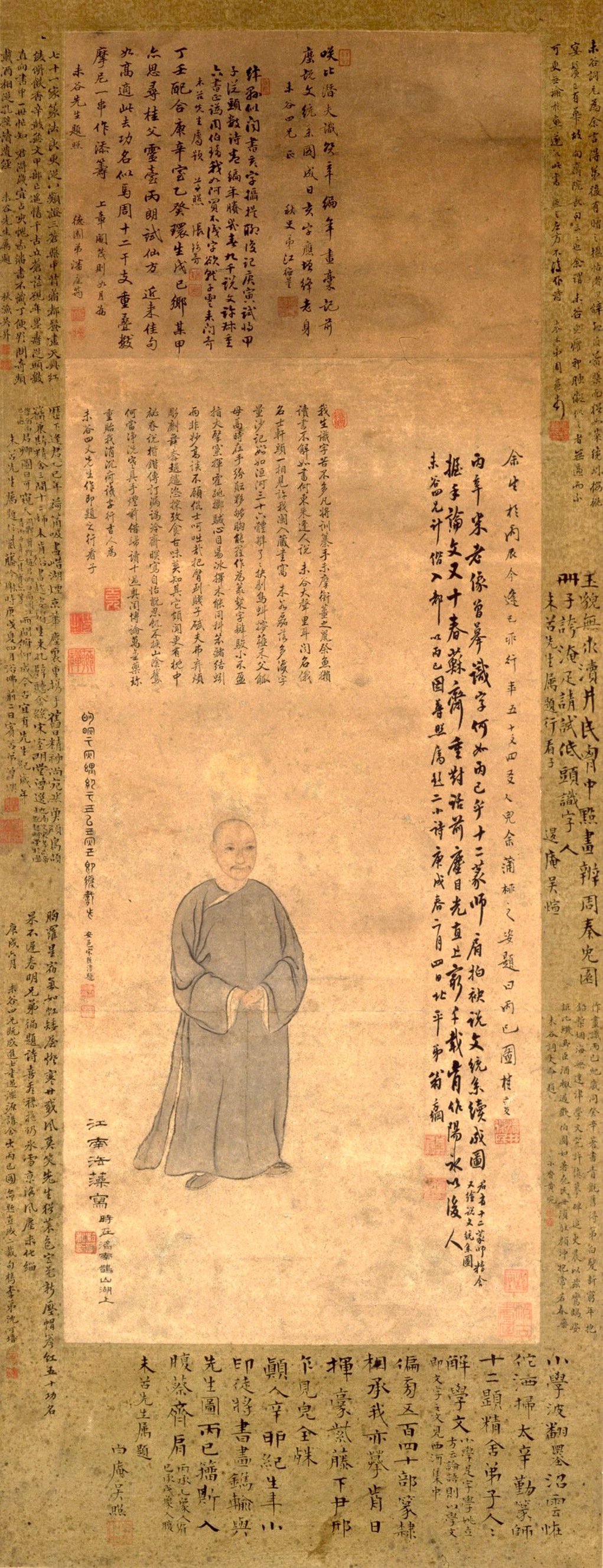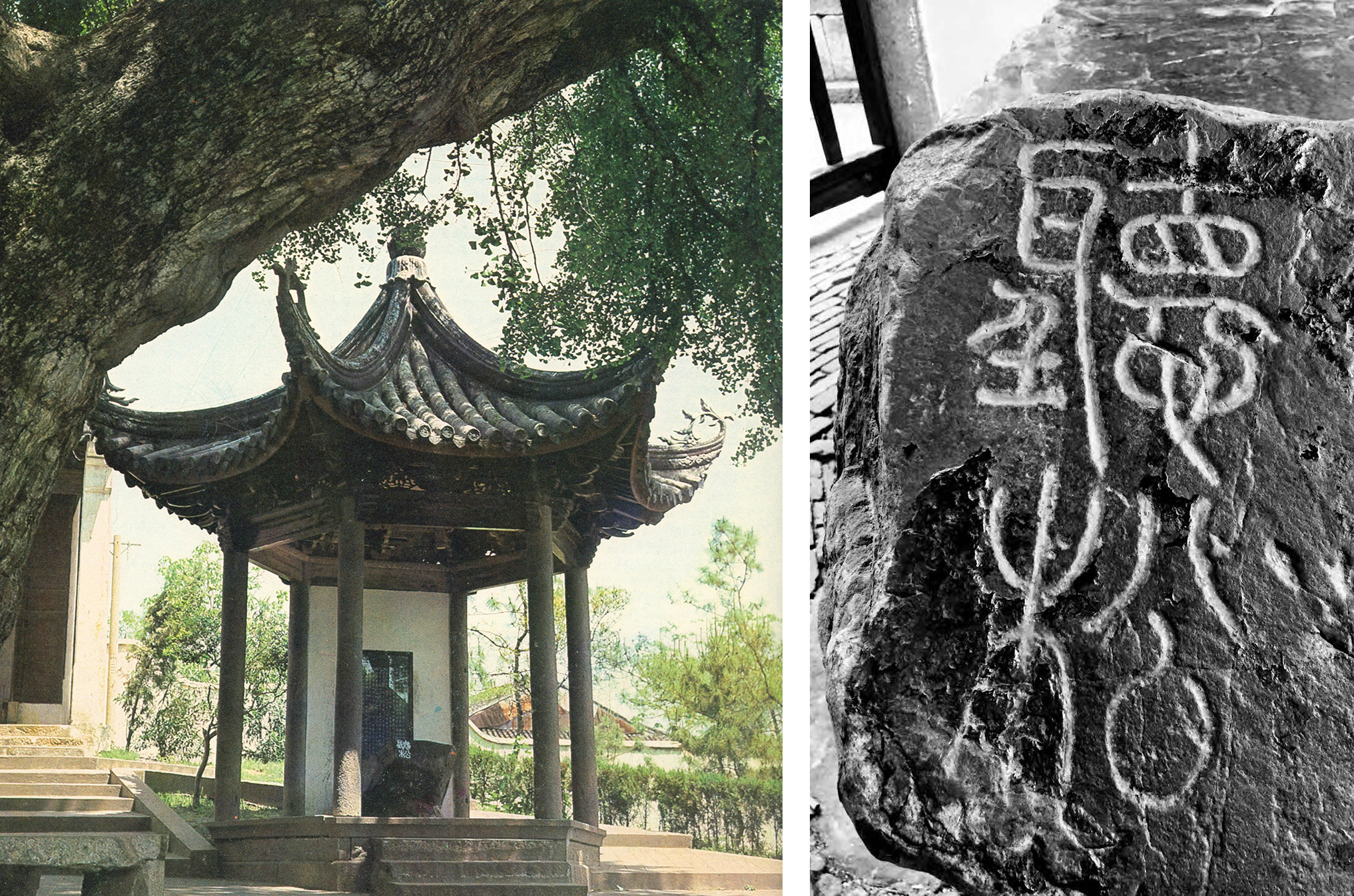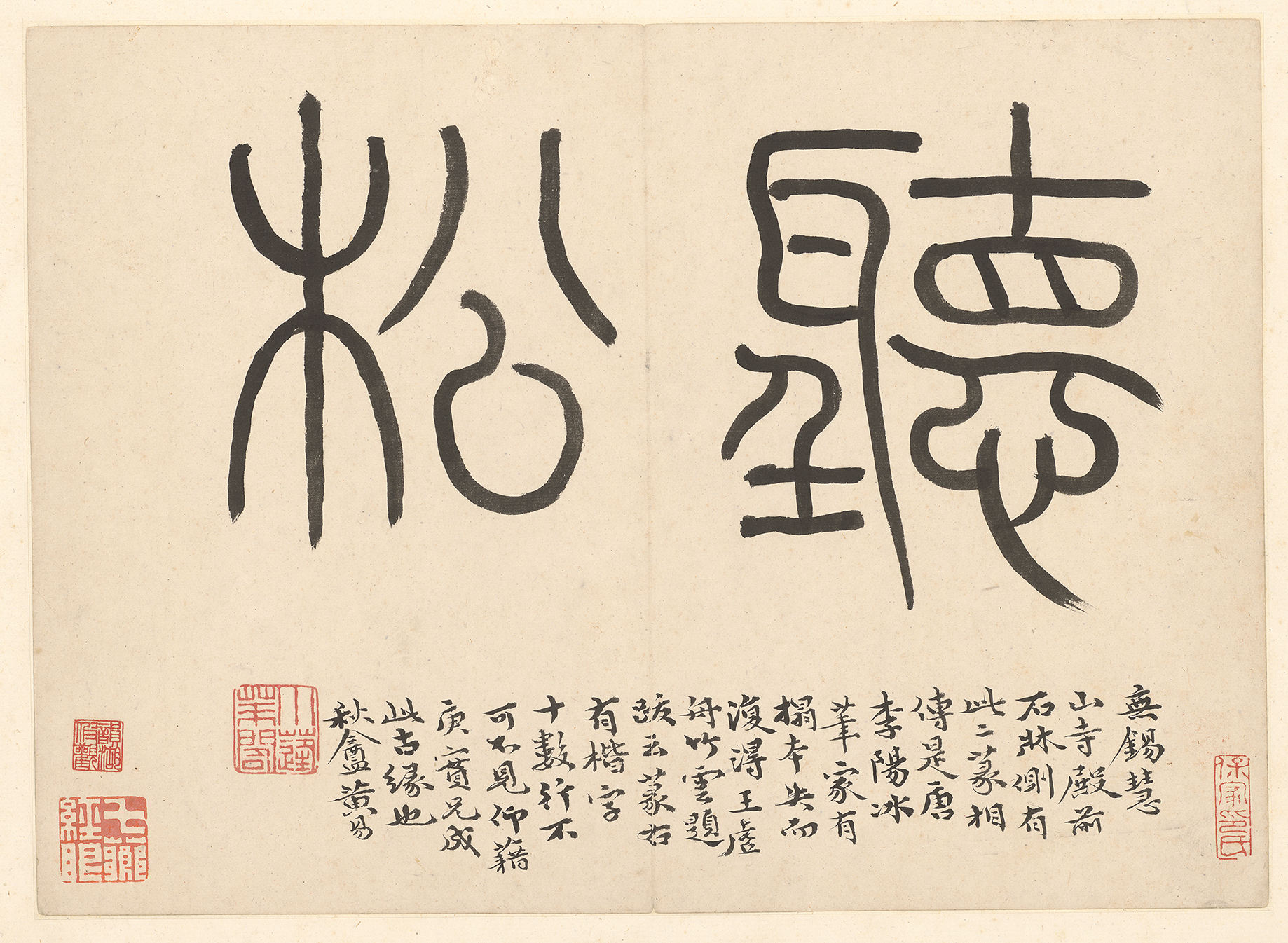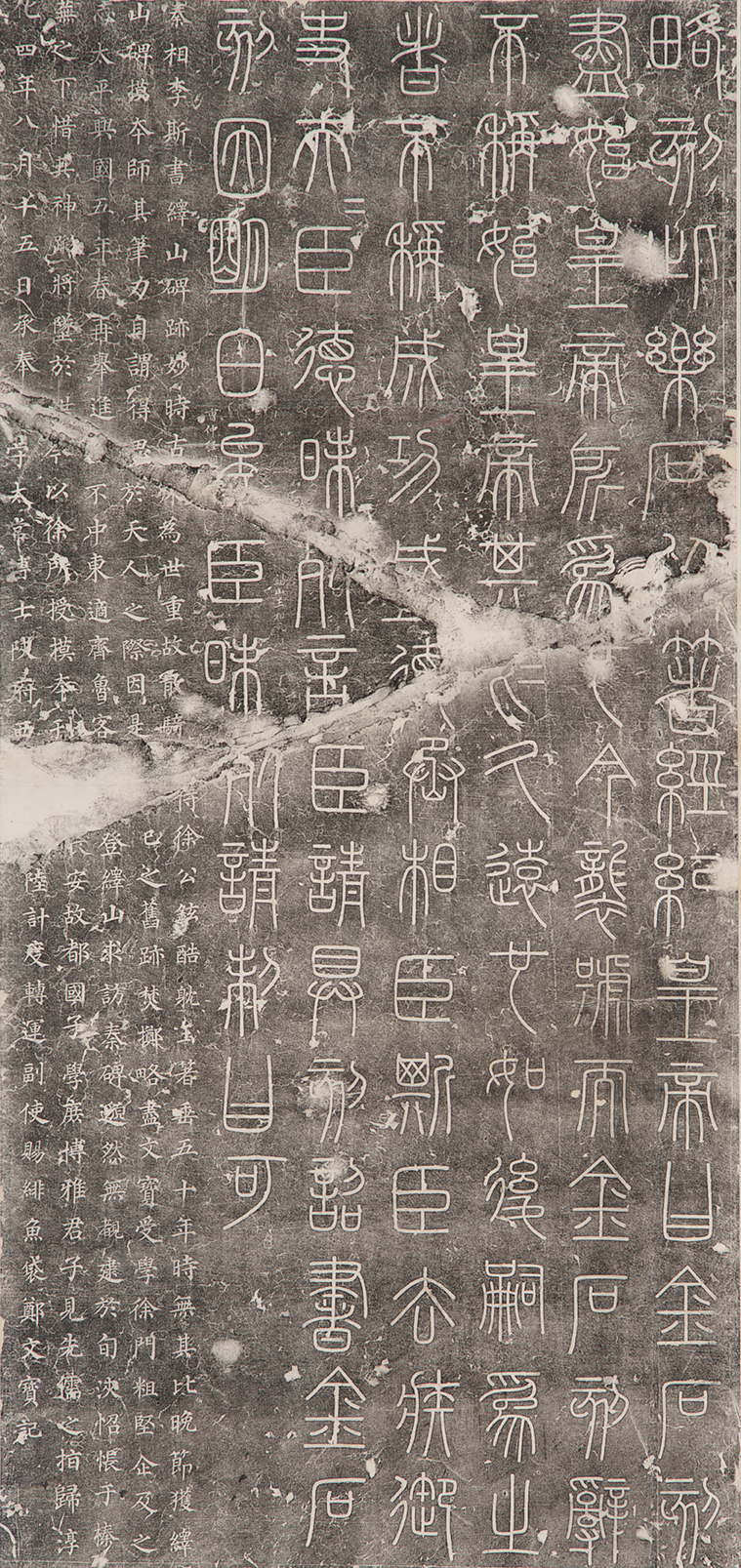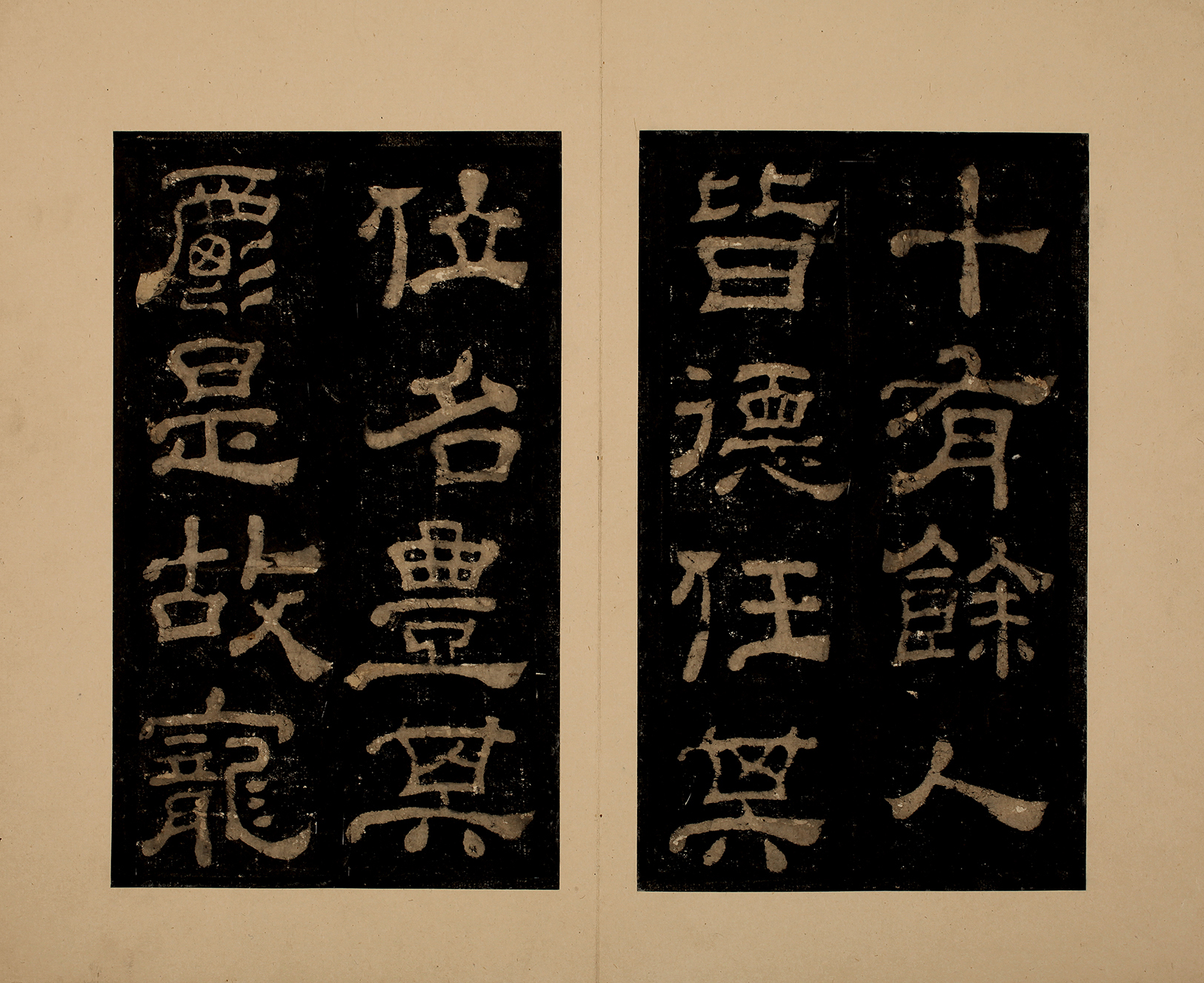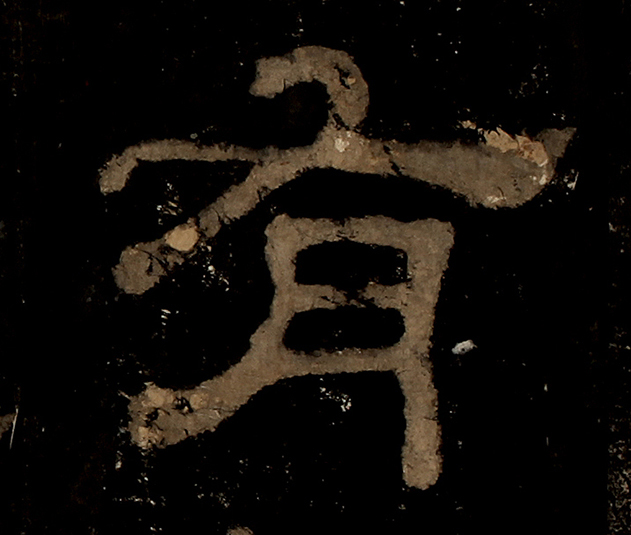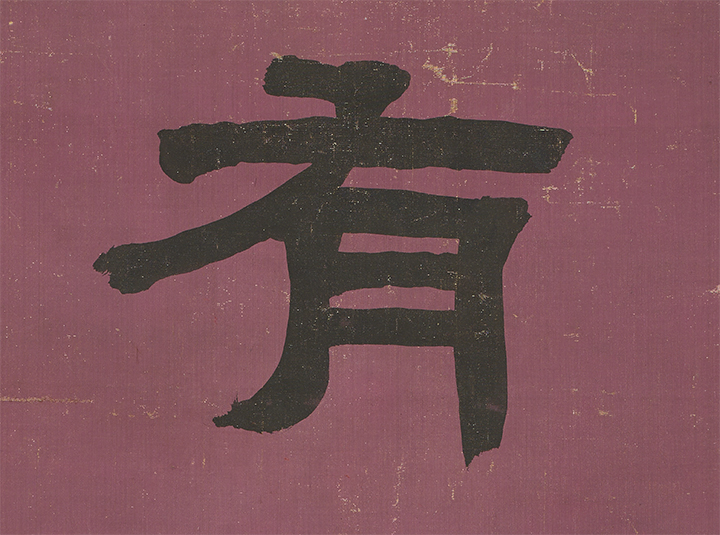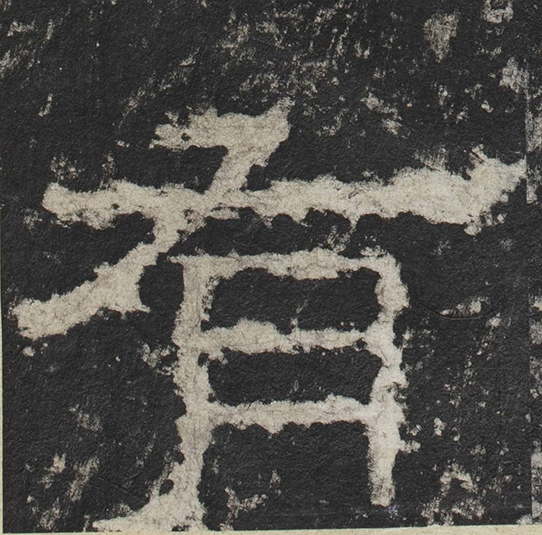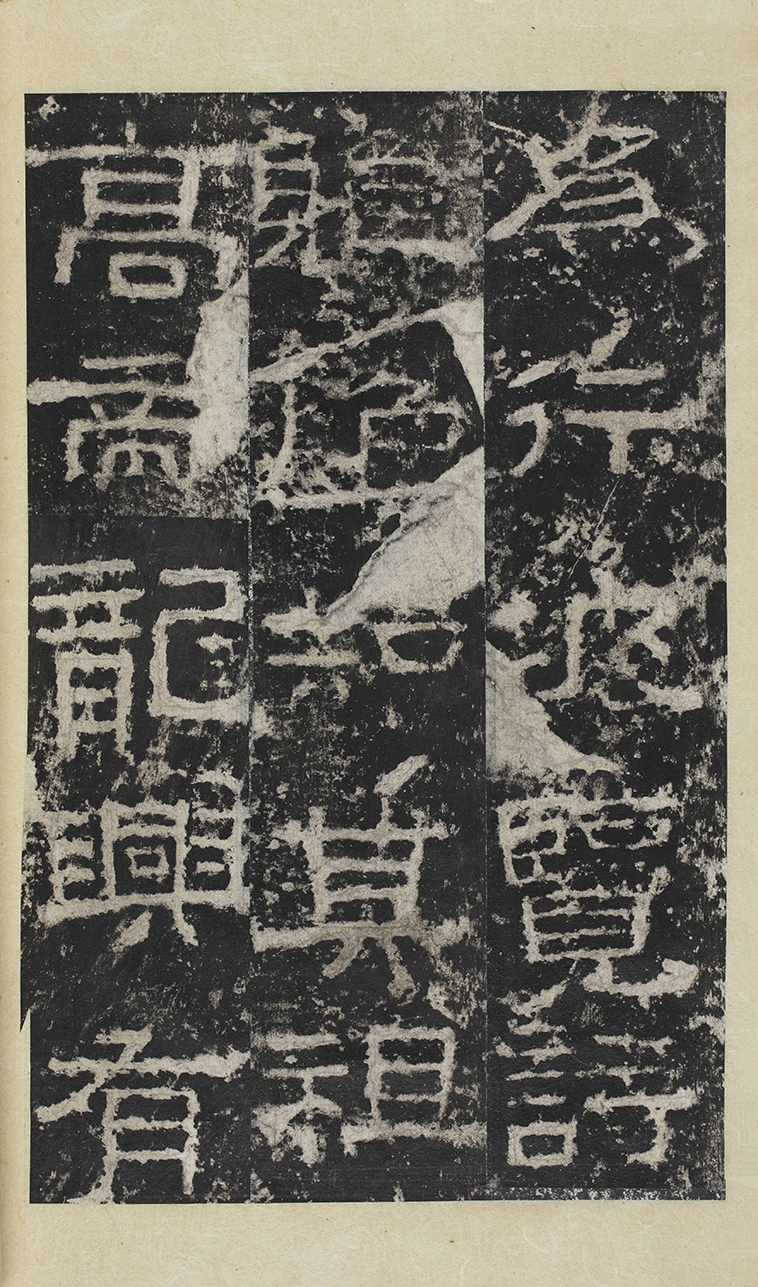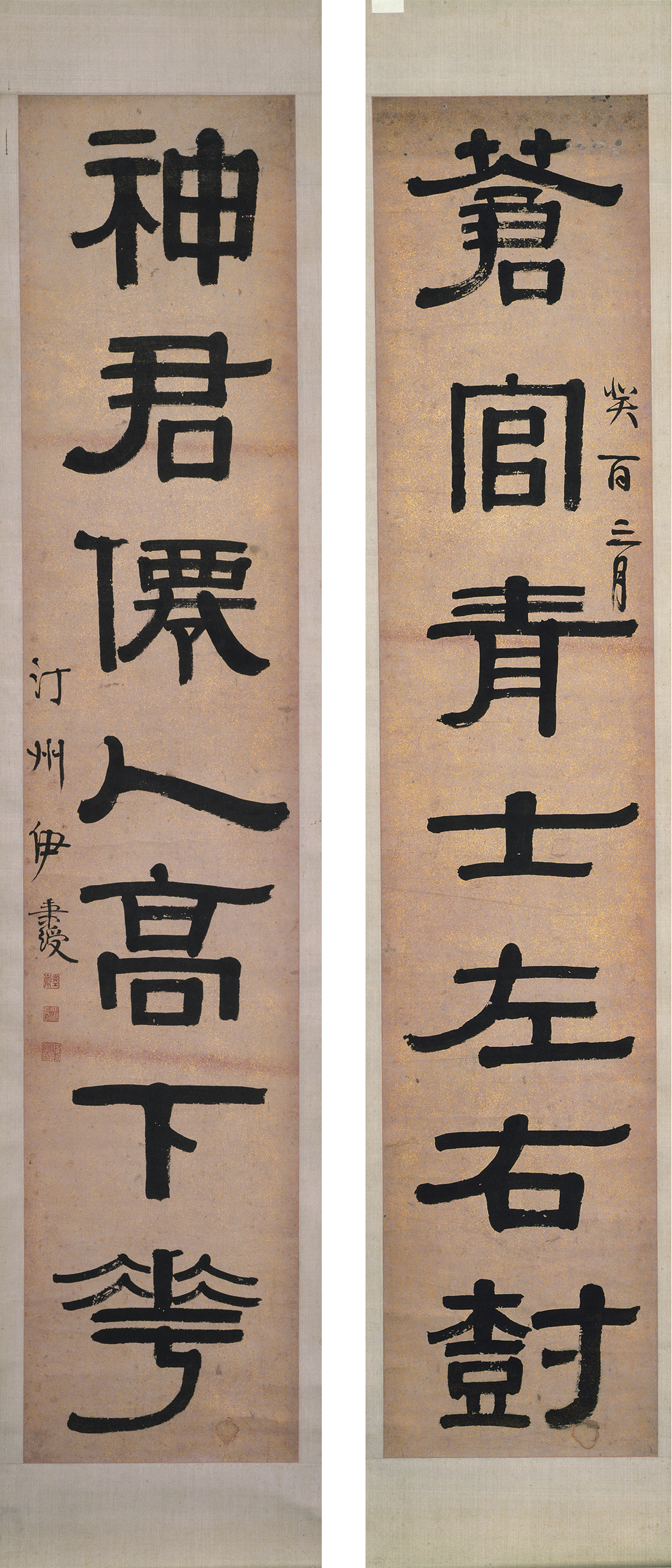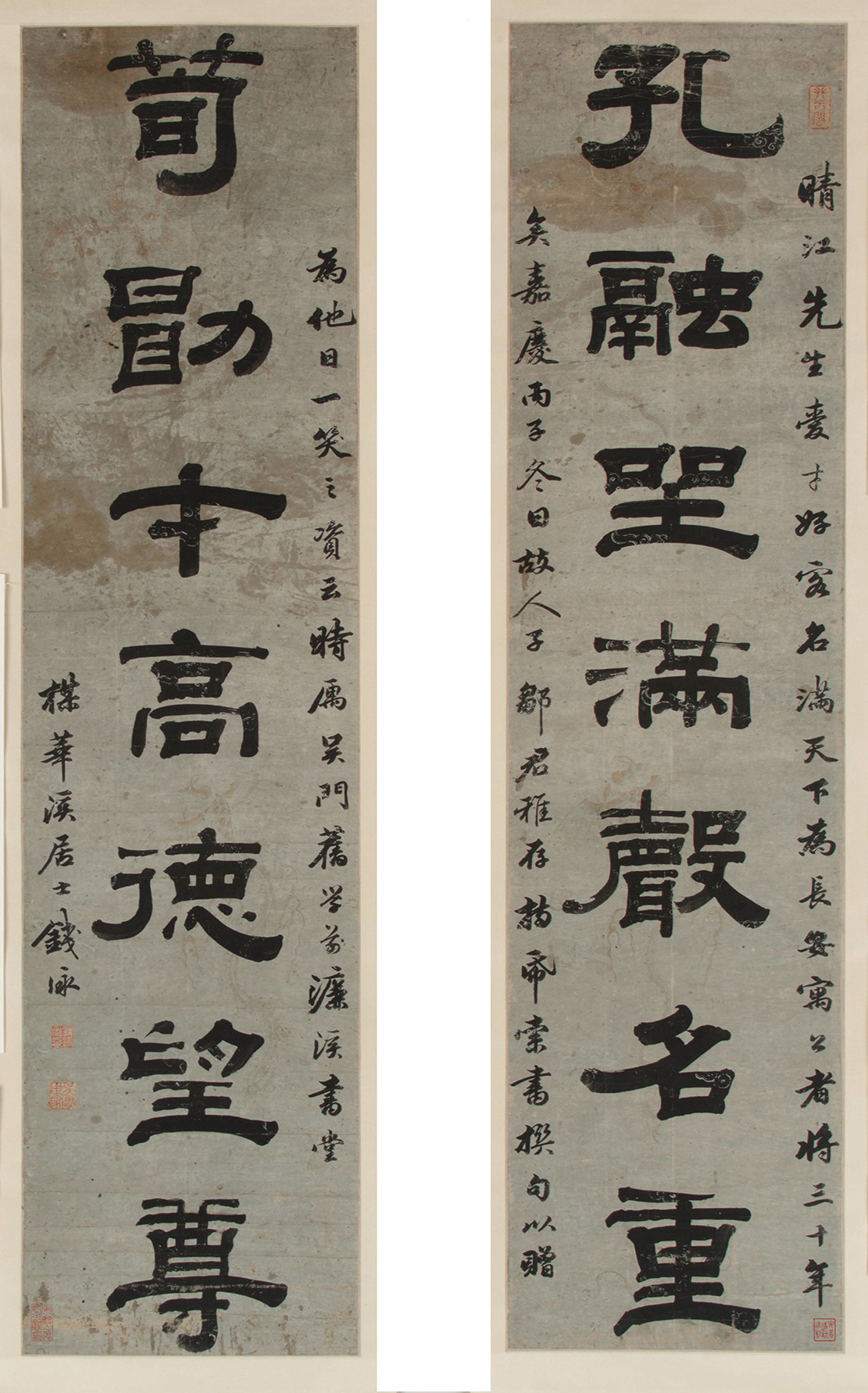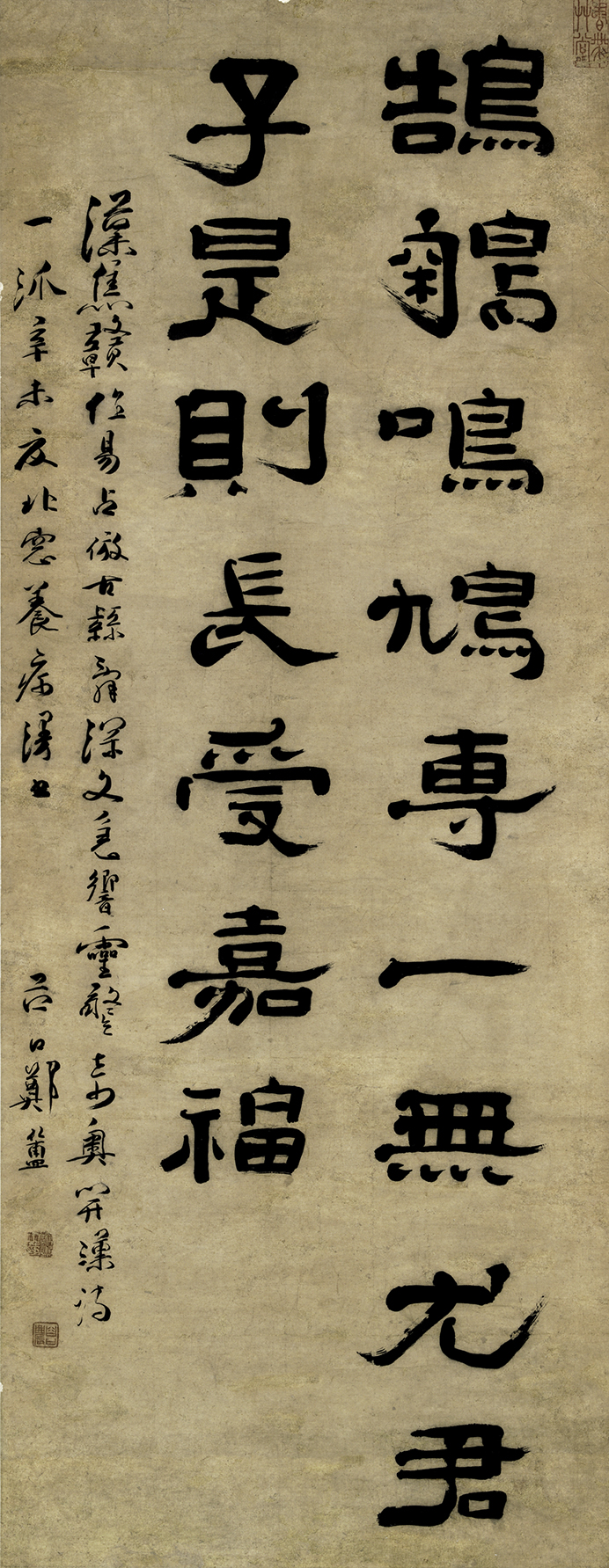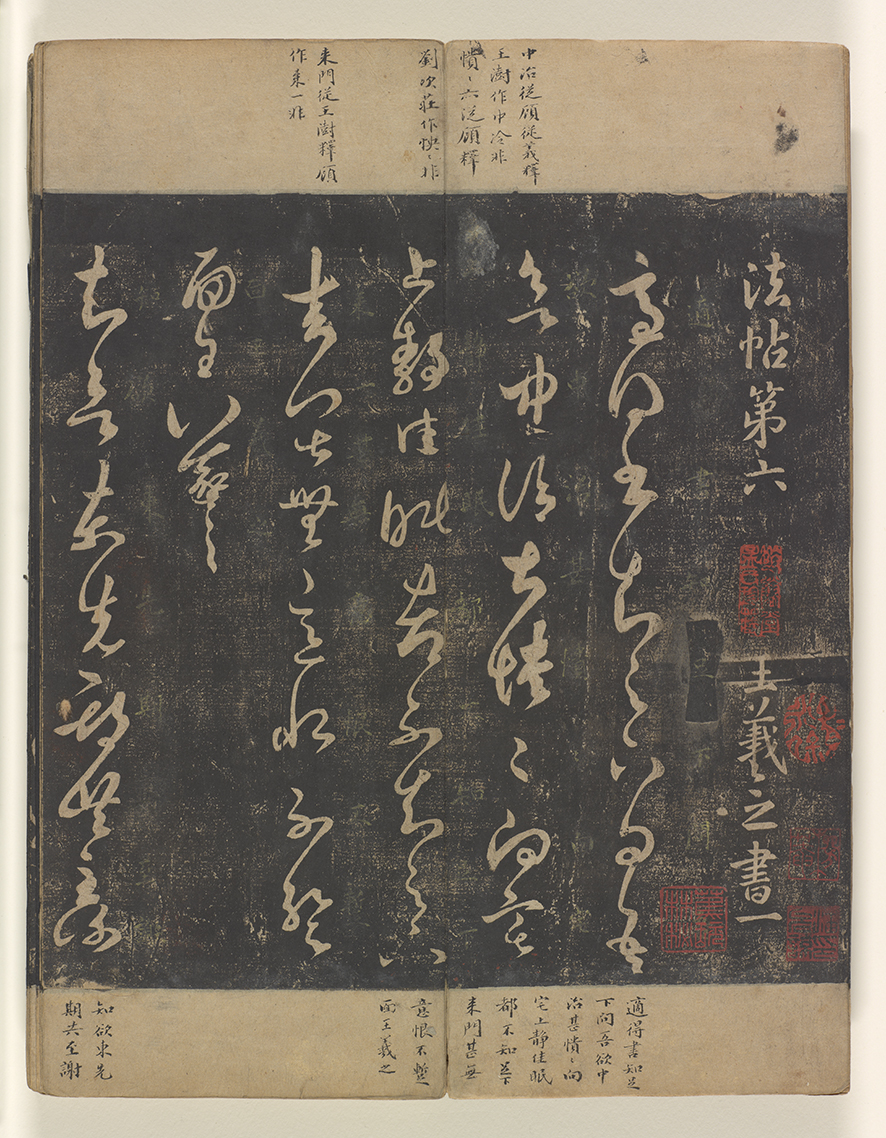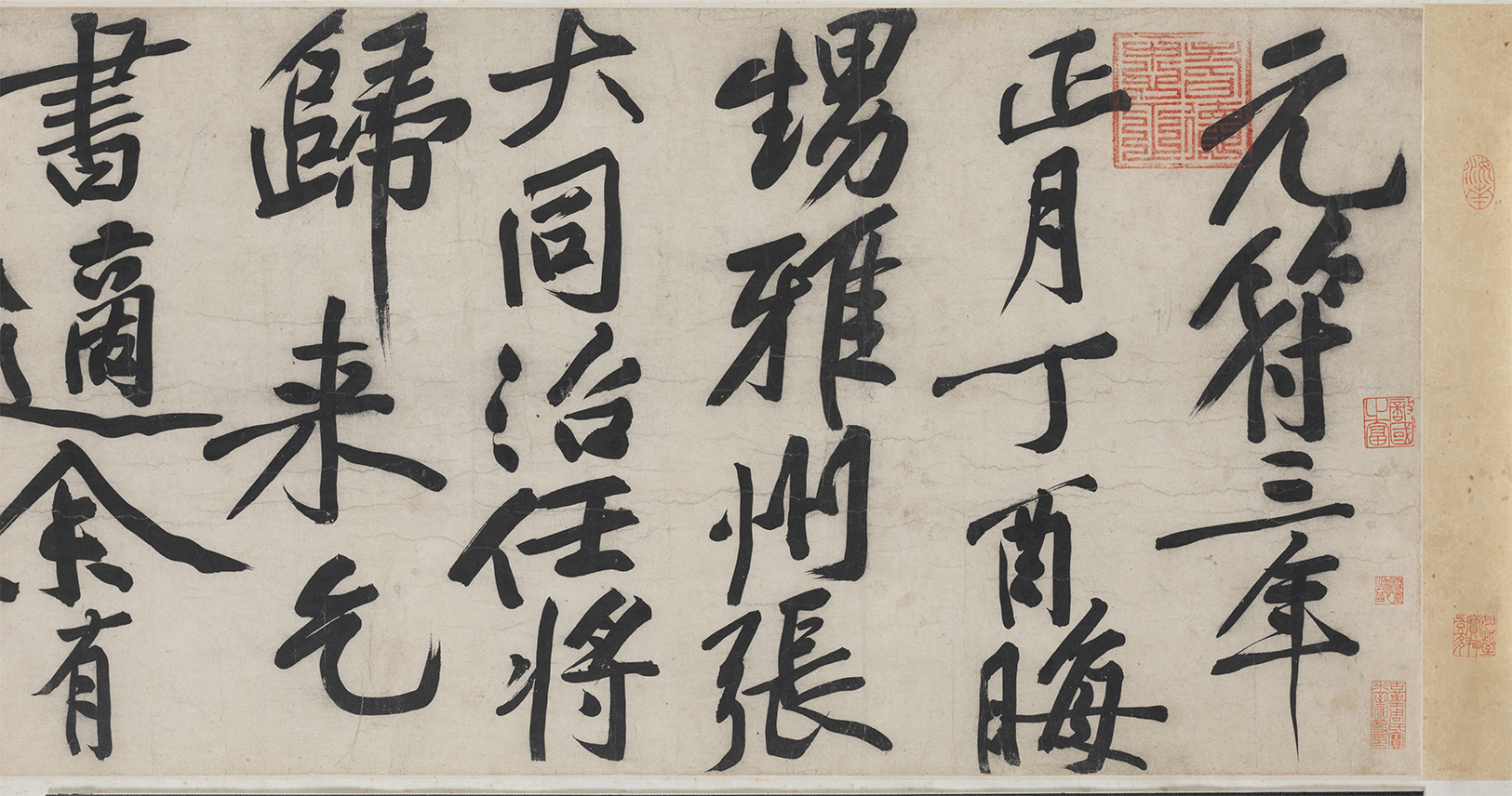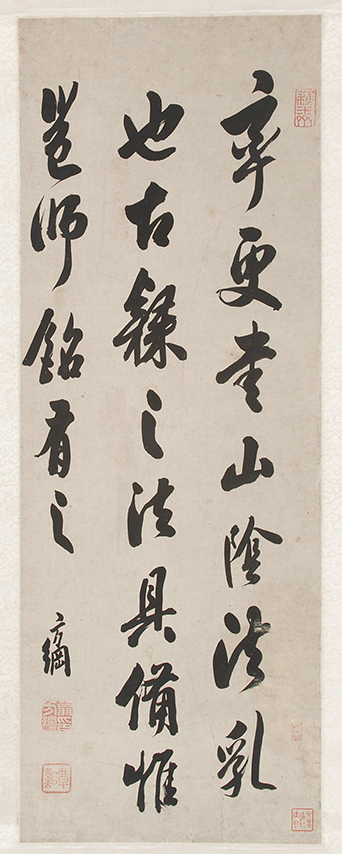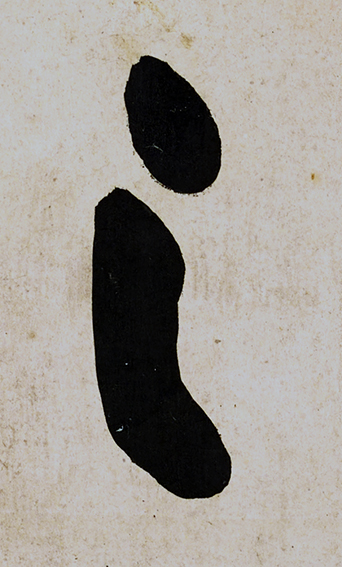A transmitter and not a maker, trusting in and loving antiquity.1 述而不作,信而好古。
From Lunyu 論語 (the Analects)
Introduction
A pair of five-character poetic verses, archaic in form and austere in stroke, sits firmly on a dark, rich red couplet (duilian 對聯 or yinglian 楹聯) (fig. 1). This format, consisting of two vertical hanging scrolls, is usually hung on the parallel columns of a building as architectural decoration.2 The calligraphy is executed in clerical script (lishu 隸書), an ancient script type traditionally believed to have originated in the time of the First Emperor (259–210 BCE) of the Qin dynasty (221–206 BCE).3 The compelling visual effects of this work—quiet, unaffected, yet forceful—are generated by the careful, almost mechanical alignment of unmodulated brushstrokes. Most characters in this work are symmetrical and compact, featuring individual strokes that appear uniform and ample. It is not hard to imagine that the writer maintained an extremely even speed of writing while steadily holding the brush. One could even describe these brushstrokes as “vigorous,” “substantial,” and “heavy,” terms that evoke the engraved characters on some early stone monuments.
Such visual language illuminates a preferred mode of stylistic expression among scholars interested in epigraphic calligraphy during the second half of the eighteenth century.4 Starting in the seventeenth century, epigraphic materials (e.g., engraved texts on freestanding steles, natural cliffs, bronze vessels, and ceramic tiles) emerged as new models for Chinese calligraphy because scholars viewed these inscriptions as authentic and uncorrupted examples of early calligraphic styles.5 Gui Fu 桂馥 (1736–1805), the author of Couplet in Clerical Script at the Freer Gallery of Art of the Smithsonian’s National Museum of Asian Art, belonged to a group of epigraphists who specialized in evidential research (kaozheng 考證) (fig. 1). This methodology, still widely used today, advocates that from rigorous textual analyses one can gather reliable evidence to restore the meanings of Confucian classics and dynastic histories.6 Consequently, the investigation of epigraphic inscriptions and transmitted texts became a valued field of inquiry during this period. Gui and his friends, through extensive research of historical documents, were able to reconstruct a style of clerical script that they believed to be congruent with the development of Chinese writing and representative of Confucian value.
This article offers a close reading of the calligraphic couplet by Gui Fu, with an emphasis on its references to early textual artifacts. Couplet in Clerical Script exemplifies Qing scholar-artists’ keen interest in using ancient inscriptions, fabled stories, and early aesthetic beliefs to pinpoint episodes in history that would appear meaningful within their social context. Evidential scholars of this period were not just experts in historical texts but also devout believers in those materials. Their erudition is best exemplified by their ability to navigate numerous challenging exegeses of classical texts and to piece together what might have happened in the past. Their faith is shown by their assertion that the lived experiences of ancient people could be reimagined through textual documents. Calligraphy done by this group of intellectuals often embodies such transhistorical knowledge and cultural imagination. For the work under discussion, Gui turned to a wide range of sources, including Han (206 BCE–220) steles, Tang (618–907) poems, Song (960–1279) letters, and seventeenth-century colophons, in the hope of channeling equally erudite viewers to moments in time signaled by those textual artifacts. In addition, these conscious references reinforced the historicity of the calligraphic style as well as its embodied aesthetic experience.
The following discussion centers on three types of textual artifacts that Gui Fu alluded to in Couplet in Clerical Script. The first section concerns an engraved stone monument. In 1793, Gui dedicated the work to Huang Yi 黄易 (1744–1801), a prominent antiquarian scholar with a similar passion for stone inscriptions. Gui perhaps selected the pair of poetic lines to evoke the multisensorial experience of an early stone inscription in Wuxi that had enchanted Huang for years. The bodily interactions with the monument described in an earlier poem constituted an integral part of the historical enjoyment of this inscription. The second section of the discussion explores the style of the work in relation to the traditional belief about the origins of the Chinese writing system. Gui and his friends fashioned a style of plain and vigorous brushwork using the narrative of the invention of clerical script. Moreover, these antiquarians also made use of extant Han steles to support the historicity of this new visual language. The final section situates the possible aesthetic experience of the work in a well-known calligraphic discourse of the eleventh century. The thick and unmodulated brushstrokes in the couplet resonate with Song commentary that equates such stylistic features with human characteristics of honesty and sincerity. This connection produced another experience of the couplet, one in which the calligraphy became a portrait of the writer’s personal traits. The calligraphic work is thus simultaneously a monument of friendship, a milestone in the development of Chinese writing, and a perpetuation of medieval aesthetics.
A Multisensorial Gift
Couplet in Clerical Script is a gift whose meanings were predicated on experience shared by a group of like-minded friends. In the eighteenth century, evidential scholars frequently exchanged material objects, not just as a social convention, but also as a mode of collaborative scholarship. Common examples include ink rubbings of epigraphic inscriptions, small inkstones with brief engravings, calligraphic scrolls emulating ancient steles, and paintings inspired by antiquarian activities. These objects allowed scholars to inform each other of new discoveries in the field, debate the identification of ancient characters, and exchange thoughts on early calligraphic styles. Moreover, some of these occasional works are like memory capsules, preserving episodes of a personal journey in the quest for ruined historic monuments. The work by Gui is one such material object embodying both scholarly pursuits and personal desires.
A native of Shandong, Gui Fu was a well-respected paleographer, philologist, and calligrapher of his day.7 Like many scholars in his generation, Gui did not gain much success in his political career but attained cultural distinction mainly through his textual studies. Since his youth, he had been particularly interested in collecting ancient seals and therefore gained a profound knowledge of seal script (zhuanshu 篆書), one of the earliest forms of Chinese writing. In his early thirties, Gui traveled to Beijing to search for opportunities and was quickly recognized by the antiquarian circle of Weng Fanggang 翁方綱 (1733–1818). A towering court academician, Weng was a scholar of stone inscriptions and an influential tastemaker at the time.8 Gui regularly participated in literary gatherings in Beijing, through which he built a reputation for himself as an erudite scholar in ancient Chinese writing. He produced several publications on the study of Chinese characters, including his own dictionary on a variant type of seal script.9 Later, when Gui returned to Jinan, Shandong Province, he devoted himself to the promotion of local culture. There he raised funds to build Tanxi Academy (Tanxi jingshe 潭西精舍), which soon became a popular site for literary gatherings and artistic productions among regional officials, literati, and students.10 Gui left Jinan in 1796 after he was appointed as the magistrate of Yongping in the far south of Yunnan Province. He died at his post in 1805 at the age of seventy.
The antiquarian network from which Gui benefited is perhaps best illustrated by the densely inscribed portrait of him in the collection of the Tokyo National Museum (fig. 2).11 Dated to 1789, the image was produced by an obscure painter named Fazao of Jiangnan 江南法藻 (dates unknown). The figure at the center is depicted in a three-quarters view against a blank background. He wears a light blue robe and clasps his hands before him. The plain and undecorated garment is meant to underscore the identity of Gui as a true scholar who did not care for exterior embellishment. In his self-inscription, Gui indicates that the painting was made for his fifty-fourth birthday. Several noted scholar-officials of the late eighteenth century, including Weng Fanggang, Jiang Deliang 江德量 (1752–1793), and Zeng Yu 曾燠 (1760–1831), joined this celebration through their inscriptions on the portrait.12 Many of these texts identify Gui as a person who knew how to “comprehend characters” (shizi 識字), a glowing appraisal in the eighteenth century. Cheng Yaotian 程瑤田 (1725–1814), a prominent evidential scholar at the time, considered “comprehending characters” to be the most daunting task of his occupation.13 These contemporary comments on the painting celebrated the stature of Gui as a capable paleographer whose skills were essential to the interpretation of classical texts. The scroll, as a social document, creates the image of a learned antiquarian and situates him in the community that made such cultural representation desirable.
The scholarship of Gui is marked by his trust in ancient texts and early exegeses. He was among a group of Qing scholars who offered new annotations to Shuowen jiezi 說文解字 (Explanation of graphs and analysis of characters), the first complete dictionary of Chinese characters, compiled by Xu Shen 許慎 (ca. 30–124) of the Eastern Han (25–220).14 As pointed out by Ori Sela, Shuowen studies proliferated in the second half of the eighteenth century because this dictionary was a useful philological aid.15 A clear understanding of Shuowen offers a foundation for more accurate readings of other classical texts. The approach Gui adopted to study Shuowen, however, differed from some of his contemporaries.16 Many scholars at the time prioritized the phonological investigation of Shuowen. Characters that bore a similar pronunciation, in their view, implied a shared etymological origin and therefore a close semantic relationship. In contrast, Gui focused on the meticulous excavation of texts. To explicate the meaning of a given character, he conducted an exhaustive search of its historical uses in ancient documents and used them to instantiate the interpretation of the character in Shuowen. Such a text-based approach was rooted in the exegetical tradition of Shuowen. Noted commentators of the dictionary from the Song to the Yuan (1271–1368) dynasties engaged in similar painstaking comparisons of different early sources. Gui was proud to be a follower of this lineage of scholarship.17 His study of Shuowen reflects his belief in the power of texts to speak for themselves. Gui never aimed to produce meanings for early documents but only to organize exegetic texts that could illuminate the words of the ancients.
Analogous to his reliance on ancient texts for etymological studies, Gui also used these texts to uncover historical experience in his artistic creation, as exemplified by the Freer couplet. In this work, the symmetry of the overall composition and the unwavering brushstrokes compel a sense of awe, enhancing the poetic imagery produced by the text, which reads:
No one around, the moon is about to set. Buddha is here, the pines do not speak.18
無人月欲下,有佛松不言。
These parallel verses are from the poem “Night Vigil at the Temple of King Aśoka (Ayuwang si yezuo 阿育王寺夜坐)” by Wang Siren 王思任 (1575–1646).19 A man of Shanyin (present-day Shaoxing, Zhejiang Province), Wang was an acclaimed writer of the Ming dynasty (1368–1644) who came to be recognized for his descriptive travel accounts in finely evocative language. One of his well-known essays is about the famous sites of Jinan in Shandong.20 Gui’s interest in the cultural history of his native place must have sparked his appreciation for the literary works of Wang. In the above poem, Wang depicted a series of quiet and desolate scenes he experienced during an evening visit to the temple of King Aśoka in Ningbo. Such a sense of tranquility was further magnified by Gui’s plain, unmodulated, and unfluctuating brushstrokes in the calligraphic couplet. Through the solemn style of clerical script, the audience was guided to relive Wang’s late-night stay at the empty monastery.
The inscription on the couplet states that the calligraphy was intended as a gift for Huang Yi, a renowned aficionado of stone inscriptions in the eighteenth century:
For the ninth elder brother Xiaosong (Huang Yi). Master connoisseur, please correct my clerical-script calligraphy. At the time we were both in Jining [of Shandong Province]. On the sixteenth day of the eighth lunar month in the guichou year (September 20, 1793). A casual copy. Yunmen Gui Fu.21
小松九兄,法家正隸,時同在濟寧,癸丑八月既望,偶臨,雲門桂馥。
The passage suggests that Gui transcribed these poetic lines for Huang during their meeting in 1793. At the time, Huang was as an associate administrator of the canal (yunhedao tongzhi 運河道同知) in Jining.22 Among the circle of Weng Fanggang, Huang was best known for his restoration of ancient steles in Shandong and his pilgrimage to the ruined monuments in Henan.23 His impressive collection of epigraphic materials made him a valued member of this antiquarian community. Several extant letters between Gu and Huang document their frequent exchanges during their time in Shandong. In the eleventh month of 1788, Huang carved a seal for Gui, who returned a calligraphic couplet.24 In 1792, Gui and Huang hired an artisan who specialized in making ink rubbings to search for early inscriptions at Tianzhushan 天柱山 in Shandong.25 In the seventh month of 1793, Gui asked Huang to acquire ink rubbings of ancient steles in Jining and Qufu for him. These letters also contain details of their reciprocal relationship. Huang not only shared his on-site knowledge with Gui but also provided him access to ink rubbings of important inscriptions. In return, Gui offered his calligraphic skill as well as access to a local network.
For this group of scholars, ancient artifacts played a huge role in their commemoration of friendship. In the tenth month of 1793, for example, Huang invited several friends on his fiftieth birthday to look at an ink rubbing of a broken stele. Dated to the second year (173) of the Xiping Era (172–178), this fragmented monument was a recent discovery of Huang in Qufu, Shandong. He also produced a painting for the event.26 The picture depicts a garden setting in which three figures stand indoors to examine an ink rubbing, while two additional figures engage in conversation in a neighboring room. In his colophon next to the image, Huang recorded that his fiftieth birthday happily coincided with the finding of the “Xiping stele.” His guests came to drink wine with him while celebrating his birthday through the ancient inscription.
Similarly, Gui’s couplet is perhaps meant to speak about their shared interests in epigraphy, evoking the sensory experience of an ancient inscription that had fascinated Huang Yi for some years. This inscription consists of two large seal-script characters reading “Hearken to the Pines (tingsong 聽松),” carved on a polished rock boulder at Huishan Temple in modern-day Wuxi, Jiangsu Province (figs. 3 a,b).27 The work was traditionally attributed to the Tang calligrapher Li Yangbing 李陽冰 (ca. 721–787). A colophon of 1791, written on an ink rubbing of this inscription, suggests that Huang was deeply captivated by the content and style of the stone inscription.28 In this colophon, Huang first transcribed an early comment by the Qing scholar Wang Shu 王澍 (1668–1743):
The Gazetteer of Xishan (present-day Wuxi) says that Huishan Temple has a stone couch, located beneath the moon railing in front of the main hall. Its length is about five chi (approximately 5½ feet), and its width is half of [the length]. It has a flat surface that allows one to recline and look up. Therefore, it is called the “stone couch.” On one side of the stone, there are two seal-script characters, tingsong (Hearken to the Pines), which is said to be brushed by Li Yangbing of the Tang. [The inscription] appears aged and fluid and has an archaic tone. It cannot be by someone other than Yangbing. The poem by Pi Rixiu (834–883) of the Tang says, “At dusk, wind rises high in front of the hall; note after note, pinecones hit the stone couch.” Such was [how one “hearkens to the pines”]. . . .29
錫山志慧山寺有石牀,在殿前月臺下。長可五尺廣厚半之。上平,可供偃仰,故名石牀。頂側有聽松二篆字,傳是唐李陽冰筆。蒼潤有古色,斷非陽冰不能。唐皮日休詩 “殿前日暮高風起,松子聲聲打石牀” 是也. . . .
The passage by Wang Shu describes a somatic experience of the inscription prompted by its materiality.30 Visitors who only saw the inscription may wonder how one could listen to pine trees. Indeed, pines cannot make sound, but the contact between pinecones and the stone couch brought about a sonic element. Once visitors had reclined on the stone couch, they might recall Pi Rixiu’s poem and relate the inscription to its surrounding environment. A proper experience of the inscription thus involved not just reading the engraving but also lying on the stone to feel the wind and hear the fall of pinecones.
The detailed firsthand account by Wang Shu, who traveled to Huishan Temple to enjoy the inscription in person in 1728, must have inspired Huang to imagine a similar journey. In the second half of the colophon, Huang regrets that he has visited Jiangsu several times but never had a chance to closely examine the work in situ.31 In 1793, Huang decided to copy these two seal-script characters for the poet Yin Hongwei 印鴻緯 (active ca. 1800) because Yin had agreed to make an ink rubbing of this inscription for him (fig. 4).32 It is unclear if Huang and Gui talked about the inscription during their meeting in 1793. Nevertheless, Gui’s couplet resonates with the engraving at Huishan Temple in the shared imagery of pines and temple. While Huang Yi may have regretted never “hearing” the pine trees at Huishan Temple, Gui Fu could have consoled him, almost with a sense of humor, that pines may not always “speak.” The couplet thus not only elicited Huang’s desire for the seal-script inscription but also underscored the multisensorial experience of the engraved calligraphy in Wuxi.
Ancient Style Reconstituted
Couplet in Clerical Script was also meant to perform an ancient calligraphic style that, in Gui Fu’s mind, followed the historical origin of clerical script. In the inscription, Gui used lin 臨 (lit., “to copy”) to designate his calligraphy as “a casual copy.” The term originates from the freehand copies designed to capture the stylistic features of established calligraphic models. However, in the seventeenth century the concept expanded to denote the performative interpretation of early calligraphic works.33 Katharine Burnett has rendered this concept as “innovative transcription,” highlighting the agency of calligraphers who “maintain the originary text but transform the style.”34 Amy McNair has compared the practice to “music compositions that can be played many ways.”35 Their insights suggest that these so-called “copies” in late imperial China were a type of creative performance. Calligraphers engaged in “copying” to perform their stylistic preferences and cultural knowledge. For evidential scholars, this kind of innovative transcription was an opportunity to showcase their textual expertise, especially the ways in which such text-derived knowledge could help verify and reinforce historical narratives. This updated notion of “copy” thus suggests a line of inquiry related to the style of the Freer couplet: what is the style used by Gui to transcribe the poem of Wang Siren, and how does the style represent his conception of the history of Chinese writing?
Gui’s writings shed light on these questions. In his essay “Explaining Clerical Script” (Shuoli 說隸), Gui stated the following:
When writing in clerical script, if one does not clearly understand seal script, the idea that [these two scripts] are interchangeable cannot be known. If one does not examine enough stele inscriptions, the idea that [these two scripts] involve the increase or reduction [of strokes], and that they borrow [components] from one another, cannot be known. In its inception, clerical script was a transformation from seal script, and it thus maintains a close relationship with seal script. Its multiple mutations [in later times] are like the great-great-grandchildren of the earliest ancestor, the shared headwaters flowing into different branches, and the wine derived from the rice.36
作隸,不明篆體,則不能知其變通之意,不多見碑版,則不能知其增減假借之意。隸之初变乎篆也, 尚近於篆。既而一變再變,若耳孫之于鼻祖矣,又若水之同源異派矣,又如酒之脫卻米形矣。
The text reveals Gui’s desire to return to the origin of clerical script. The investigation of how various cultural conventions—for example, writing script, object type, place name, and regional custom—emerged in the first place is at the core of evidential scholarship. By tracing the sources of those cultural conventions, scholars could gain an understanding of their later development, thereby illuminating “the meanings and principles” (yili 義理) of the world.37 Gui here pointed out a consensus that clerical script developed from seal script. The relationship between the two scripts underscores that they are not distinct categories but have significant stylistic similarities. The study of ancient epigraphic inscriptions offered abundant examples for Gui to substantiate this relationship. He therefore argued that good clerical-script calligraphy should be based on the method of seal script.
This proposal, in essence, is a retelling of the origin myth of clerical script. The story had been recorded in several classical texts and functioned as a part of the traditional narrative on the invention of Chinese writing. For example, Zhang Huaiguan 張懷瓘 (ca. 8th century), the famed Tang historian of calligraphy, described the emergence of clerical script as follows:
As for clerical script, Cheng Miao, a man of Xiagui from the Qin, created it. Miao’s style name was Yuancen. At the beginning he served as a prison officer in the county’s office. When he was convicted, the First Emperor imprisoned [Cheng Miao] in Yunyang. Ruminating [in the jail] for ten years, [Miao] transformed the square and round shapes of big and small seal scripts into three thousand characters of clerical script. Presenting them to the First Emperor, who thought [this invention] could be of good use, [Cheng Miao] was appointed as the Imperial Censor. Because memorial presentations [at the court] were frequent and numerous, yet characters of seal script were difficult to write, clerical script was thus used. Because clerks [used it] to aid the [speed] of writing, it was therefore called clerical script.38
案隸書者。秦下邽人程邈所作也。邈字元岑。始為衙縣獄吏。得罪。始皇幽系雲陽獄中。覃思十年。益大小篆方圓而為隸書三千字。奏之。始皇善之。用為。禦史。以奏事繁多。篆字難成。乃用隸字。以為隸人佐書。故名隸書。
The passage above establishes that clerical script was adapted from seal script, an idea that had been reiterated by Gui in his writing. Building upon this, Gui interpreted that the earliest form of clerical script should have maintained some stylistic characteristics of seal script. While clerical script is simplified and distinctive, he believed that it embodied the principles of seal script because of their shared origin.
While many of the original monuments of seal script, such as the state-sponsored stele inscriptions of the Qin dynasty, had long been lost, eighteenth-century scholars were able to gain some idea about their styles through early copies of those inscriptions.39 For example, the Stele of Mount Yi (Yishan bei 嶧山碑), attributed to the Qin statesman Li Si 李斯 (d. 208 BCE), survives in a reengraved copy made by Xu Xuan 徐鉉 (916–991) and Zheng Wenbao 鄭文寶 (953–1013).40 An ink rubbing of this tenth-century re-engraving at the Freer Gallery shows the perceived hallmarks of the Qin seal script: the structure of each character is utterly symmetrical, and individual strokes are uniform and even (fig. 5).
The formal qualities of Qin seal script could also be found in the clerical-script couplet by Gui, especially in his emphasis on structural balance and even brushstrokes. These stylistic similarities suggest that the artist applied the brush method of seal script to his writing of clerical script. By this intentional choice of style, Gui asserted his belief in seal script as the origin of clerical script.
Although the criteria of “abbreviation” were never specified in this historical narrative, Gui Fu and his friends turned to renowned Song scholars for evidence. The study of engraved texts first emerged as a specialized inquiry known as Jinshixue 金石學 (study of bronze and stone inscriptions; commonly translated as “epigraphy”) in the eleventh century.41 As classical examples of this tradition, the inscriptive catalogues by three of the most notable epigraphists— Ouyang Xiu 歐陽修 (1007–1072), Zhao Mingcheng 趙明誠 (1081–1129), and Hong Gua 洪适 (1117–1184)—were frequently referred to by later antiquarian scholars.42 In one calligraphic couplet, Huang Yi even identified these treatises as collectively representing the timeless standards of epigraphy.43 The legacy of Song scholars was thus instrumental in the study of clerical script during the eighteenth century. A notable example is from the work of Hong Gua. In a comment on an anonymous inscription in Sichuan, Hong described what he considered to be the predominant feature of clerical script:
The method of clerical script originated in the Qin dynasty. Perhaps because it was simple and easy, scribes and clerks used it to facilitate the writing of office documents. The dots and strokes [in clerical script] do not possess the dynamic configuration of upward and downward [brush] movements. . . . Looking at these few characters, one can observe the model writing at the time.44
隸法雖自秦始,蓋取其簡易,施之徒隸,以便文書之用,未有點畫俯仰之勢。. . . 觀此數字可見當時之書法也。
Hong here identified the lack of movement in brushstrokes as a sign of the earliest style of clerical script. While the inscription Hong saw is no longer extant, “dynamic configuration” in the text could have referred to a type of highly animated clerical script later developed during the Han period. For instance, the Stele for Xia Cheng (Xia Cheng bei 夏承碑) of the Eastern Han is known for its intensely gestured brushstrokes (fig. 6).45 The longest horizontal stroke in the character you 有 (lit., “to have”) possesses both “upward and downward movements,” because it is not only fluctuating but also heavily modulated toward the end (fig. 7). In contrast, the same character in Gui’s work presents an even and stable horizontal stroke (fig. 8). It appears that Gui intentionally avoided those wavering brushstrokes, probably with reference to the statements by distinguished Song epigraphists such as Hong Gua. In doing so, he proclaimed the ancient source of his clerical-script calligraphy and reimagined the origin of clerical script.
Evidential scholars also used surviving stele inscriptions, such as the Zhang Qian Stele (Zhang Qian bei 張遷碑), to support the historicity of this style of clerical script. Dated to 186, the Zhang Qian Stele was originally erected in Dongping County of Shandong Province as a memorial to an unrecorded minor official, one Zhang Qian of the Eastern Han period. This monument is most celebrated for the plain, unmodulated, and sharp-edged strokes. Some characters on the stele feature strokes of even thickness (fig. 10). The starting point of each stroke is often marked by a distinct square edge. The uniform, blunt, and forceful brushstrokes are also reminiscent of the formal characteristics of seal script. In the Freer couplet by Gui, the character you displays a striking resemblance to the same character in the Zhang Qian Stele in terms of the overall shape and stroke modulation (see fig. 9).
In the eighteenth century, the Zhang Qian Stele was taken up by Weng Fanggang and his close associates as one of the preferred models of clerical script.46 After examining the stele in person in 1779, Weng wrote a long poem about his experience. Two lines from the poem touch upon the style of the inscription and how it represents the authentic style of the “clerk”:
The method of clerical script originates from [the writings] of clerks.
[The Zhang Qian Stele] shows the genuine, unadorned idea of that time (Qin dynasty):
Slanted brushstrokes, not in the shape of bird tails; the leftward strokes, not in the form of waves. With the dynamic configuration of [each character], the brushstrokes come into their natural vertical and horizontal positions.47隸法從來出徒隸,猶見當年真朴意。 側非隼尾撇非波,隨勢縱橫成位置
In Weng’s view, the Zhang Qian Stele signifies an ancient style of clerical script because it appears plain and unadorned. The “bird tails” and “waves” here refer to the kind of gestural brushstrokes that could be observed in the Stele for Xia Cheng. Weng seemed to agree with Hong Gua that the earliest form of clerical script should not have such flamboyant brush movement. The even and ample brushstrokes in the Zhang Qian Stele thus testify to the historical development of clerical script. Identifying the inscription as “the style of the clerk,” Weng fashioned the Zhang Qian Stele into a fountainhead of clerical script.
Other prominent calligraphers in the circle of Weng Fanggang also embraced this type of plain and dense brushstroke. For example, Yi Bingshou 伊秉綬 (1754–1815), a close friend of Weng and Gui, gained distinction for his study of the Zhang Qian Stele.48 The straight and powerful brushstrokes in his Couplet on Venerable Officials evoke characters from this Han monument (fig. 11). Qian Yong 錢泳 (1759–1844), another noted calligrapher of the period, also promoted this style of clerical script.49 His Couplet in Clerical Script in the Freer Gallery features similar even and dense brushstrokes (fig. 12). These extant works indicate that belief in the original style of clerical script evolved into a shared visual language in the late eighteenth century.
The Idea of “Substantial and Thick”
In addition to its value as an authentic historical style, this mode of clerical-script calligraphy was also theorized by scholars around Gui as an expression of sincerity. One of the basic tenets in the practice of Chinese calligraphy is that “writing is the delineation of the mind.”50 This age-old belief allowed later calligraphers to justify their own stylistic choices and distinguish themselves from others. Gui and his close associates were known to have criticized their predecessor Zheng Fu 鄭簠 (1622–1693), whose clerical-script calligraphy was popular in the first half of the eighteenth century.51 The signature style of Zheng, as shown by one of his extant works, stresses tenuous, sometimes erratic, brushstrokes (fig. 13). The character wu 無 (lit., “not have”), for example, appears animated due to the wavering and tilted horizontal strokes. In contrast, the same character by Gui conveys stability through the strong and uniform brushwork. Many evidential scholars maintained that the “broken” quality of Zheng’s brushwork deliberately simulated the worn surface of aged stone monuments, thereby deviating from ideals of authenticity and spontaneity.52 To their eyes, Zheng’s style of handwriting revealed an ostentatious person, disingenuous by the standard of the Confucian ideal. To remedy this “defect,” they promoted even and unaffected brushwork because an early aesthetic concept had equated such stylistic expression with the image of an authentic and truthful man.
Weng Fanggang was one of the central figures who put this stylistic choice in established aesthetic terms. He adopted the term zhihou 質厚, “substantial and thick,” as a prescription for the ideal calligraphy and poetry.53 In one colophon, Weng essentialized such qualities as the most important principle of Chinese calligraphy:
Though calligraphy is a minor field of study. After the seal and clerical scripts, the standard script was developed. After [the styles of] the Han and Wei (220–266) periods, [the styles] of Jin (266–420) and Tang (618–907) periods were established. If [this development] were summarized in one phrase: it is to be substantial and thick.54
書雖小道,而篆隸之後變為正楷,漢魏之後結為晉唐,蓋一言以蔽之,曰質厚而已矣。
In Confucian classics, the meanings of zhi, or “substance,” and hou, or “thickness,” usually stand in opposition to wen 文, or “embellishment.”55 Identifying someone as “substantial and thick” means that the person does not care to be “embellished” and is thus upright and honest. This dichotomy often prioritizes the unadorned and sincere expression of oneself as the most desirable manner of artistic and literary production. Weng employed this archaic rhetoric to fashion himself and his group into unpretentious models.
The term zhihou also evoked a preferred method of brushwork that had been well enunciated in the art criticism of medieval China. Huang Tingjian 黃庭堅 (1045–1105), a renowned calligrapher and poet of the Song dynasty, had promoted the idea of zhihou in his calligraphic practice. In a letter, he argued that one should model the “substantial and thick” brushstroke in ancient calligraphy:
[You] are very engaged with learning calligraphy. During the spare time after the cultivation of moral character and the study of classics, [calligraphy] is indeed a hobby superior to others. However, one must take the ancients as the teacher. Although the method of brush aims to be clear and energetic, the substantial and thick [brushstroke] must be the foundation. When ancients talked about calligraphy, they considered the firm and forthright [brushstroke] that sinks [into the paper] as good. Tang-dynasty calligraphers compared the calligraphy of Xu Jihai (Xu Hao 徐浩, 703–782) to “an angry tiger wresting a rock” and “a thirsty stallion racing toward a spring.” [From these metaphors one may] understand the general idea of what [the ancients considered as good]. Among the mistakes of calligraphy, seductive beauty is a trivial flaw, while frivolity is a significant illness. One must directly lay each brushstroke in an upright and regular position. Then, when those brushstrokes are released, the running-script calligraphy can be made naturally. Although cursive-script calligraphy is cursory, the intention of each brushstroke should be upright and regular. Most important, one should avoid deliberately decorating and stitching [each brushstroke]— this is not what makes calligraphy.56
承頗留意於學書,修身治經之餘,誠勝他習。然要須古人為師,筆法雖欲清勁,必以質厚為本。古人論書,以沉著痛快為善。唐之書家,稱徐季海書如怒猊抉石,渴驥奔泉,其大意可知。凡書之害,姿媚是其小疵,輕佻是其大病,直須落筆一一端正。至於放筆,自然成行,草則雖草,而筆意端正,最忌用意狀綴,便不成書。
The above passage clarifies the value of zhihou. Huang defined the term as a style of brushstroke that is not only sturdy but also vigorous, likening it to the outburst of energy often associated with powerful animals such as the tiger and horse. Characters constructed by such brushstrokes would be “substantial and thick” because they appear to “sink (chen 沉)” into the surface of the paper, almost as if they were engraved.
In addition, Huang contrasted zhihou with zimei 姿媚, or “seductive beauty,” another critical concept in calligraphic theories. Amy McNair has pointed out that the latter term was used as a metonym for the style of Wang Xizhi 王羲之 (303–361), the Sage of Chinese calligraphy.57 Because none of his original works are extant, the style of Wang is most clearly exemplified through trusted early copies.58 The fluent flow of intensely modulated inked lines in Upon Receiving Your Letter (Shideshutie 適得書帖), an engraved copy of a short letter by Wang, are representative of his cursive-script calligraphy (fig. 14). The work is collected in the Chunhua getie 淳化閣帖 (Model letters in the Imperial Archives in the Chunhua Era), a famed calligraphic compendium first compiled in the late tenth century.59 Such floating, gestural, and conscious movement of the brush is exactly what Huang tried to argue against: the frivolous and pretentious use of the brush. Huang believed that the “substantial and thick” brushstroke was an authentic ancient method because it avoided deliberate embellishment and did not appear overly decorative. It is quite likely that Weng shared this conviction and appropriated the concept as a pathway toward spontaneity.
Both Huang Tingjian and Weng Fanggang put the theories they advocated into practice. Their extant calligraphic works illustrate how they incorporated such moral concepts in their artistic creations. In Scroll for Zhang Datong, Huang employed a thick and vigorous brushstroke to “engrave” each large character on the paper (fig. 15). The beginning section of each stroke is solid and firm, generating an impression of the great strength that the artist had conveyed to his brush. In Comments on Calligraphy, Weng seemed to have maintained a slow speed of writing to allow each solid brushstroke to fully saturate the absorbent paper (fig. 16). The z-shaped component in the character zhi 之, for example, is almost reduced to a round vertical line (fig. 17), while the use of dense ink adds to the overall feeling of “thickness.” Weng transformed all the sharp-edged strokes into a plump inked silhouette. Although these two works differ from Gui’s Couplet in Clerical Script in terms of personal style and script type, they share a visual language that favors the use of the heavy and centered brushstroke. Such a stylistic choice suggests that Gui followed Weng and Huang to develop his own “substantial and thick” brushwork expressing a genuine and unadorned self-image.
Conclusion
This article has attempted to unpack the meanings of Gui Fu’s Couplet in Clerical Script to his contemporary audience. With the amplification of evidential research in the second half of the eighteenth century, scholars made use of transmitted texts and stone inscriptions to reconstruct episodes of the past that they believed to be historically authentic, culturally significant, and personally meaningful. The couplet reflects an inventive application of this scholarly methodology in the artistic arena. In 1793, Gui prepared the couplet as a gift to Huang Yi, who at the time was fascinated by the early inscription “Hearken to the Pines,” a seal-script engraving on the stone couch at Huishan Temple in Wuxi. According to a Tang poem, one should not only view this intriguing monument and read its inscription, but also rest upon it to feel the wind and hear the drop of pinecones. Gui chose these poetic lines, which contain tropes of temple and pines, to simulate the multisensorial experience associated with the inscription in Wuxi. The selection of this textual content was significant because it enabled Huang to envision a historical experience that he had long desired.
The couplet also presents Gui’s interpretation of clerical script in its uniform and vigorous brushstrokes. In particular, the artist adopted the brush method of seal script to reimagine the correct form of clerical script but avoided its animated and gestural style because those formal features were not considered historically accurate. Gui and his friends drew on extant stele inscriptions to substantiate their claims about the principle of clerical script. The style of the Zhang Qian Stele, for example, accords with what they conceived of as the original style of clerical script. The square and unmodulated brushstrokes in the stele soon evolved into a popular stylistic source during the period. Weng Fanggang then infused this type of brushstroke with the idea of “substantial and thick.” First articulated by Huang Tingjian in the eleventh century, this aesthetic concept promotes the upright and compact brushstroke—as opposed to the “seductive” style of Wang Xizhi—as an honest expression of the writer. To the antiquarian community of the eighteenth century, this style of clerical script signified not just an authentic style from the past but also a genuine representation of the self. Thus, the Freer couplet by Gui Fu details how evidential scholars appropriated textual artifacts to commemorate social relationships, pursue stylistic innovation, and justify aesthetic preference.
Acknowledgments
Research for this article began when I was a Smithsonian Predoctoral Fellow at the National Museum of Asian Art. I am grateful to Jan Stuart, Stephen Allee, Sana Mirza, Lizzie Stein, and Shu Yue for their help and support during the fellowship period. An earlier version of this paper was presented at the annual conference of the Association for Asian Studies in 2022. I would like to thank Christopher Foster and Anke Hein for inviting me, and Birgitta Augustin for her invaluable feedback. Conversation with Michael J. Hatch and Michele Matteini also sparked many ideas for this paper. My special thanks go to the two anonymous reviewers who offered critical suggestions on the manuscript, and Mary Cason for her attention to details. I am in debt to the kind colleagues who offered generous assistance with images in the article: Xue Longchun, Zoe Song-Yi Kwok, Joseph Scheier-Dolberg, Kaka Chung, and Josh Yiu. Finally, the article could not have been completed without the mentorship, patience, and encouragement of Professor Amy McNair.
Author Biography
Weitian Yan, PhD (University of Kansas), 2022, is an Assistant Professor in the Department of Art History, Indiana University, Bloomington. His research focuses on the history of Chinese calligraphy and the antiquarian culture of late imperial China. E-mail: yanweit@iu.edu
Notes
- For the translation, see Burton Watson, trans., The Analects of Confucius (New York: Columbia University Press, 2007), 48. For the original Chinese text, see Cheng Shude 程樹德, Lunyu jishi 論語集釋 (Collected annotations of the Analects) (Beijing: Zhonghua shuju, 1990), 2:431. ⮭
- For the origin and function of the calligraphic couplet, see, for example, Cary Y. Liu, “Calligraphic Couplets as Manifestations of Deities and Markers of Buildings,” in The Embodied Image: Chinese Calligraphy from the John B. Elliot Collection, ed. Robert E. Harrist and Wen Fong (Princeton, NJ: Art Museum, Princeton University, 1999), 361–79; Ronald Egan, “Literary Aspects of the Calligraphy Couplets,” in Double Beauty: Qing Dynasty Couplets from the Lechangzai Xuan Collection, ed. Jason C. Kuo and Peter C. Sturman (Hong Kong: Art Museum, Chinese University of Hong Kong, 2003), 16–24; and Bai Qianshen 白謙慎, “Duilian zayi” 對聯雜議 (Assorted discussion on couplets), in Double Beauty II: Qing Dynasty Couplets from the Lechangzai Xuan Collection, ed. Harold Mok (Hong Kong: Art Museum, Chinese University of Hong Kong, 2007), 26–30. ⮭
- In the standard narrative about the invention of different script types, Cheng Miao 程邈 (ca. 200 BCE), a low-ranking clerk of the Qin dynasty, was named as the “founder” of clerical script; see Zhang Huaiguan 張懷瓘, “Shu duan” 書斷 (Judgments on calligraphy), in Fashu yaolu 法書要錄 (Important records on model calligraphy), by Zhang Yanyuan 張彥遠 (Shanghai: Shanghai guji chubanshe, 2013), 166–67. I discuss this traditional belief below, in the section “Ancient Style Reconstituted.” Scholars in recent decades have used archaeological findings, such as covenant texts in Houma and Wenxian during the Spring and Autumn Period (ca. 771–476 BCE) and bronze inscriptions from the Warring States Period (ca. 475–221 BCE), to investigate the phenomenon of libian 隸變 (lit., “the transformation of clerical script”), especially how clerical script evolved from earlier script types. The issue is important because the basic structure of clerical script serves as the foundation of the Chinese writing system that remains in use today. A rather progressive view is that the characteristics of clerical script had already emerged on covenant texts during the late Spring and Autumn Period, roughly around 497–489 BCE; see Liu Fengshan 劉鳳山, “Libian yanjiu” 隸變研究 (Research on the transformation of clerical script) (PhD diss., Capital Normal University, 2006); and Tian Fang 田芳, “Libian xintan” 隸變新探 (New discoveries on the transformation of clerical script) (MA thesis, Tianjin Normal University, 2014). For a recent dating of these covenant texts, see Crispin Williams, “Dating the Houma Covenant Texts: The Significance of Recent Findings from the Wenxian Covenant Texts,” Early China 35–36 (2012–13): 247–75. A more conservative viewpoint is that the transformation of clerical script should have taken place at least by the late Warring States Period, roughly around 361–381 BCE; see Qiu Xigui 裘錫圭, Wengzixue gaiyao 文字學概要 (Chinese writing), trans. Gilbert L. Mattos and Jerry Norman (Berkeley: Society for the Study of Early China and the Institute of East Asian Studies, University of California, Berkeley, 2000), 113–18. ⮭
- For a discussion on the emergence of epigraphic calligraphy in the seventeenth century, see Qianshen Bai, Fu Shan’s World: The Transformation of Chinese Calligraphy in the Seventeenth Century (Cambridge, MA: Harvard University Asia Center, 2003). I follow Bai to term the type of calligraphy inspired by ancient epigraphic materials as “epigraphic calligraphy.” I also avoid using the term “stele school (beixue 碑學)” to address this kind of calligraphy because the term became popular in a slightly later period and is thus often used to speak about cultural and political concerns that were different from the period under discussion in the present article. For a recent discussion on the theories of the “stele school,” see Aida Yuen Wong, The Other Kang Youwei: Calligrapher, Art Activist, and Aesthetic Reformer in Modern China (Leiden: Brill, 2016). ⮭
- Bai, Fu Shan’s World, 153–208; Amy McNair, “Engraved Calligraphy in China: Recension and Reception,” Art Bulletin 77.1 (March 1995): 106–14. The study of epigraphic materials first emerged in the eleventh century. Epigraphists viewed these inscriptions as authentic historical documents vis-à-vis “transmitted texts” that were compiled and edited by historians of later periods. They began using these quasi-archaeological materials to verify recorded historical events. For discussions of this intellectual tradition, see Ronald Egan, “Ou-yang Hsiu and Su Shih on Calligraphy,” Harvard Journal of Asiatic Studies, 49.2 (1989): 365–419, and “Rethinking ‘Traces’ from the Past: Ouyang Xiu on Stone Inscriptions,” in The Problem of Beauty: Aesthetic Thought and Pursuits in Northern Song Dynasty China (Cambridge, MA: Harvard University Asia Center, 2006), 7–59; Jeffrey Moser, “Learning with Metal and Stone: On the Discursive Formation of Song Epigraphy,” in Powerful Arguments: Standards of Validity in Late Imperial China, ed. Martin Hofmann, Joachim Kurtz, and Ari Daniel Levine (Leiden: Brill, 2020), 135–174. ⮭
- Benjamin Elman, From Philosophy to Philology: Intellectual and Social Aspects of Change in Late Imperial China (Cambridge, MA: Harvard University Press, 1984), and Classicism, Politics, and Kinship: The Ch’ang-chou School of New Text Confucianism in Late Imperial China (Berkeley: University of California Press, 1990); Ori Sela, China’s Philological Turn: Scholars, Textualism, and the Dao in the Eighteenth Century (New York: Columbia University Press, 2018). For examples of the impact of evidential scholarship on the antiquarian culture of late imperial China, see Michele Matteini, “The Aesthetics of Scholarship: Weng Fanggang and the Cult of Su Shi in Late-Eighteenth-Century Beijing,” Archives of Asian Art 69.1 (April 2019): 103–20, and “The Story of a Stone: Mi Fu’s Ink-Grinding Stone and Its Eighteenth-Century Replications,” Arts Asiatiques 72 (2017): 81–96; Pinyan Zhu, “Advertise Antiquity and Consume Nostalgia: Chinese Pewterware in the Thayer Collection,” in Perspective on a Legacy Collection: Sallie Casey Thayer’s Gift to the University of Kansas, ed. Celka Straughn and Kristan M. Hanson (Lawrence, KS: Spencer Museum of Art, 2020), 242–55. ⮭
- The following biography of Gui Fu is based upon: Sun Yafen 孫雅芬, “Gui Fu yanjiu” 桂馥研究 (The research of Gui Fu) (PhD diss., Shandong University, 2009); Zhang Yiwei 張毅巍, “Gui Fu nianpu” 桂馥年譜 (The chronicle of Gui Fu) (MA thesis, Harbin Normal University, 2011); and Cao Hui 曹輝, “Gui Fu shufa yanjiu” 桂馥書法研究 (Research on the calligraphy of Gui Fu) (MA thesis, Harbin Normal University, 2011). ⮭
- For important studies on the life, art, and writings of Weng Fanggang, see Matteini, “Aesthetics of Scholarship,” 103–20, and “Story of a Stone,” 81–96; Peggy Pik-ki Ho 何碧琪, “Weng Fanggang yu Qian Jia shiqi beitie shufeng ji jiancang wenhua” 翁方綱與乾嘉時期碑帖書風及鑒藏文化 (A study of Weng Fanggang: The calligraphic style and collection culture of stele and model-letters rubbings in the Qianlong and Jiaqing periods) (PhD diss., National Taiwan University, 2011); Shen Jin 沈津, Weng Fanggang nianpu 翁方綱年譜 (Chronicle of Weng Fanggang) (Taipei: Zhongyang yanjiuyuan Zhongguo wenzhe yanjiusuo, 2002); and Shen Jin 沈津, ed., Weng Fanggang tiba shouzha jilu 翁方綱題跋手札集録 (Collected records of Weng Fanggang’s colophons and letters) (Guilin: Guangxi shifan daxue chubanshe, 2002). ⮭
- Gui Fu 桂馥, Mouzhuan fenyun 繆篆分韻 (“Hemp seal script” in rhymed classification) (Shanghai: Shanghai shudian chubanshe, 2013). ⮭
- Gui Fu 桂馥, “Tanxi jingshe ji” 潭西精舍記 (Record of the Tanxi Academy), in Wanxueji 晚學集 (Anthology of late learning) [ca. 1794–1841], juan 7: 6–7, accessed March 1, 2022, https://archive.org/details/02103492.cn/page/n34/mode/2up. In classical Chinese, the term jingshe 精舍 often refers to a “Buddhist monastery.” However, in the eighteenth century, evidential scholars used jingshe for its Confucian origin, suggesting it was the residence of students and disciples during the Han dynasty. I thus translate the term as academy instead of monastery. For an explanation of the term, see Ruan Yuan 阮元, “Xihu gujing jingshe ji” 西湖詁經精舍記 (Record of the Classics Exegesis Academy at the West Lake), in Yanjingshi ji 揅經室集 (Anthology of the Studying Classics Studio) (1823), juan 7: 15–16, accessed December 28, 2022, https://ctext.org/library.pl?if=gb&file=79222&page=30. ⮭
- The painting is available both in the image-search database of the Tokyo National Museum, https://webarchives.tnm.jp/imgsearch/show/C0027900; and ColBase: Integrated Collections Database of the National Institutes for Cultural Heritage, Japan, https://colbase.nich.go.jp/collection_items/tnm/TA-451?locale=en. ⮭
- In total, twelve scholars inscribed the scroll: Weng Fanggang, Jiang Deliang, Zeng Yu, Song Baochun 宋葆淳 (1748–1818), Pan Tingyun 潘庭筠 (jinshi degree obtained in 1778), Zhang Jinfang 張錦芳 (1747–1792), Shen Kepei 沈可培 (1737–1799), Wu Sheng 吳昇 (act. 1780s), Wu Zhao 吳照 (1755–1811), Zhou Huang 周桓 (?) (unidentified), Wu Xuan 吳煊 (dates unknown), and Huang Wan 黄畹 (dates unknown). ⮭
- Sela, China’s Philological Turn, 89. ⮭
- Gui Fu 桂馥, Shuowen jiezi yizheng: lianyunyiben 說文解字義證: 連筠簃本 (Verification of meanings for the explanation of graphs and analysis of characters, Lianyunyi edition) (Shanghai: Shanghai guji chubanshe, 2021). ⮭
- Sela, China’s Philological Turn, 85–91. ⮭
- For modern evaluations of Gui’s contribution to the Shuowen studies, see He Jiuying 何久盈, “Qian Jia shidai de yuyanxue” 乾嘉時代的語言學 (Linguistics during the Qianlong and Jiaqing periods), Beijing daxue xuebao 北京大學學報 (Journal of Peking University), no. 1 (1984): 77–88; and Chen Donghui 陳東輝, “Lue lun Gui Fu Shuowen jiezi yizheng zhi jiazhi” 略論桂馥《說文解字義證》之價值 (On the significance of Gui Fu’s “Verification of meanings for the explanation of graphs and analysis of characters”), Guji zhengli yanjiu xuekan 古籍整理研究學刊 (Journal of Ancient Books Collation and Studies), no. 3 (1996): 1–3, 48. ⮭
- Gui Fu once asked Luo Ping 羅聘 (1733–1799) to design a group portrait of scholars whom he deemed to have properly transmitted the learning of Shuowen; see Kim Karlsson, Alfreda Murck, and Michele Matteini, eds., Eccentric Visions: The Worlds of Luo Ping (Zurich: Museum Reitberg Zürich, 2009), 71–72. The painting and its later variants deserve independent study. ⮭
- Translated by Stephen D. Allee, associate curator for Chinese Painting and Calligraphy at the Smithsonian’s National Museum of Asian Art; see https://asia.si.edu/object/F1997.46.1-2/. ⮭
- For a biography of Wang Siren, see Chaoying Fang and Mingshui Huang, “Wang Ssu-jen,” in Dictionary of Ming Biography, 1368–1644, ed. L. Carrington Goodrich and Chaoying Fang (New York: Columbia University Press, 1976), 2:1420–25. For the complete poem, see Wang Siren 王思任, “Ayuwang si yezuo 阿育王寺夜坐” (Night vigil at the temple of King Aśoka), in Wang Jizhong ji 王季重集 (Anthology of Wang Jizhong) (China: Qinghuige, ca. 1621–44), 7: seq. 226, Harvard Yenching Library, https://iiif.lib.harvard.edu/manifests/view/drs:53970973$226i. ⮭
- Wang Siren 王思任, “You Lixia zhusheng” 遊歷下諸勝 (Touring the famous sites in Lixia), in Qinding gujin tushu jicheng 欽定古今圖書集成 (Imperial encyclopedic collection of pictures and books of ancient and present times) (1726), juan 250, accessed December 28, 2022, https://zh.m.wikisource.org/zh-hans/%E6%AC%BD%E5%AE%9A%E5%8F%A4%E4%BB%8A%E5%9C%96%E6%9B%B8%E9%9B%86%E6%88%90/%E6%96%B9%E8%BC%BF%E5%BD%99%E7%B7%A8/%E8%81%B7%E6%96%B9%E5%85%B8/%E7%AC%AC0205%E5%8D%B7. ⮭
- The translation is adapted from the work by Stephen D. Allee; see https://asia.si.edu/object/F1997.46.1-2/. I would like to thank the anonymous reviewers for sharing their thoughts on the meaning of the inscription. Gui wrote a short essay on the term zhengli 正隸 (orthodox clerical script) and discussed its relation to the term sanli 散隸 (dispersed clerical script). However, there is no sufficient evidence to suggest that the essay is related to the inscription here. See Gui Fu 桂馥, “Zhengli Sanli” 正隸散隸 (Orthodox clerical script and dispersed clerical script), in Zhapu 札樸 (Plain notes) (Beijing: Zhonghua shuju, 1992), 220–21. ⮭
- For a detailed biography of Huang Yi, see Yang Guodong 楊國棟, Huang Yi nianpu chubian 黃易年譜初編 (Chronicle of Huang Yi, preliminary edition) (Jinan: Shandong huabao chubanshe, 2017). ⮭
- For the antiquarian endeavor of Huang Yi, see, for example, Michael J. Hatch, “Outline, Brushwork, and the Epigraphic Aesthetic in Huang Yi’s Engraved Texts of the Lesser Penglai Pavilion (1800),” Archives of Asian Art 70.1 (April 2020): 23–49; Lillian Lanying Tseng, “Retrieving the Past, Inventing the Memorable: Huang Yi’s Visit to the Song-Luo Monuments,” in Monuments and Memory, Made and Unmade, ed. Robert S. Nelson and Margaret Olin (Chicago: University of Chicago Press, 2003), 37–58, and “Mediums and Messages: The Wu Family Shrines and Cultural Production in Qing China,” in Rethinking Recarving: Ideas, Practices, and Problems of the “Wu Family Shrines” and Han China, ed. Cary Y. Liu (New Haven, CT: Yale University Press, 2008), 260–68; Eileen Hsiang-ling Hsu, “Huang Yi’s Fangbei Painting,” in Rethinking Recarving, 236–59; Qianshen Bai, “The Intellectual Legacy of Huang Yi and His Friends: Reflections on Some Issues Raised by Recarving China’s Past,” in Rethinking Recarving, 286–37; Qin Ming 秦明, “Huang Yi fangbeitu qianzhuan: jianlun Huang Yi fangbei situ de neizaiguanxi ji zhengtijiegou” 黃易訪碑圖前傳:兼論黃易訪碑四圖的內在關係及整體結構 (A prequel to Huang Yi’s “Visiting Steles” painting: Discussion on the inner relationship and overall structure of the four “Visiting Steles” paintings by Huang Yi), Zhongguo meishu 中國美術 (Art in China), no. 5 (2019): 82–89; Xue Longchun 薛龍春, Guhuan: Huang Yi yu qianjia jinshi shishang 古歡:黃易與乾嘉金石時尚 (The joy of antiquities: Huang Yi and the antiquarian culture of the Qianlong and the Jiaqing periods) (Beijing: Sanlian shudian, 2019), and “Huang Yi jinshi shoucang zhong de difangguan” 黃易金石收藏中的地方官 (Local officials in the epigraphic collection of Huang Yi), Taida Journal of Art History 46 (2019): 117–73; Lu Hui-wen 盧慧紋, “Hanbei tuhua chu wenzhang: cong Jining zhouxue de hanbei tan shiba shiji houqi de fangbei huodong” 漢碑圖畫出文章:從濟寧州學的漢碑談十八世紀後期的 訪碑活動 (Scholarship emerging from the illustrations and paintings of Han steles: Han steles at the academy of Jining and the survey of steles in the late eighteenth century), Taida Journal of Art History 26 (2009): 37–92; Gugong bowuyuan 故宮博物院, ed., Penglai suyue: Gugong cang Huang Yi Han Wei beike teji 蓬萊宿約:故宮藏黃易漢魏碑刻特集 (Penglai’s ancient engagements: Huang Yi’s stele inscriptions from the Han and Wei periods at the Palace Museum) (Beijing: Zijincheng chubanshe, 2010), Gugong cang Huang Yi chidu yanjiu: shouji 故宮藏黃易尺牘研究:手跡 (Research on Huang Yi’s letters at the Palace Museum: Traces of hands) (Beijing: Zijincheng chubanshe, 2014), and Gugong cang Huang Yi chidu yanjiu: kaoshi 故宮藏黃易尺牘研究:考釋 (Research on Huang Yi’s letters at the Palace Museum: Verification and explanation) (Beijing: Zijincheng chubanshe, 2015); Huang Yi 黃易, Xiaopenglai ge jinshi wenzi 小蓬萊閣金石文字 (Engraved texts of the Lesser Penglai Pavilion), in Shike shiliao xinbian disan ji 石刻史料新編第三輯 (New collection of stone engravings and historical texts, third issue) (Taipei: Xin wenfeng chuban gongsi, 1986), 1:529–650. ⮭
- Chen Mingsheng 陳名生, “Nanjing bowuyuan cang Gui Fu Wu Lü Guo Lin zhi Huang Yi si zha kaoshi” 南京博物院藏桂馥吳履郭麐致黃易四札考釋 (Verification and explanation of four letters from Gui Fu, Wu Lü, and Guo Lin to Huang Yi at Nanjing Museum), Meishudaguan 美術大觀 (Art Panorama), no. 11 (2022): 80–84. ⮭
- Xue Longchun, Guhuan, 139, and “Gui Fu, Wu Yi, He Yuanxi zhi Huang Yi jiuzha kaoshi” 桂馥武億何元錫致黃易九札考釋 (Verification and explanation of nine letters from Gui Fu, Wu Yi, and He Yuanxi to Huang Yi), Wenxian 文獻 (The Documentation), no. 2 (2020): 136–47. ⮭
- The title of the painting reads: “Xiaopenglaige hebei tu” 小蓬萊閣賀碑圖 (Felicitations on the stele at the Lesser Penglai Pavilion).” For reproductions of the painting, see Gugong bowuyuan, ed., Penglai suyue, 166–69; Qin Ming, “Huang Yi fangbeitu qianzhuan,” 82–89; Wu Mengmeng 吳萌萌, “Chashu xiangwen qie zikan: Huang Yi fangbeitu yanjiu” 茶熟香溫且自看:黃易訪碑圖研究 (Boiled tea, warm smell, and viewing alone: Research on Huang Yi’s “Visiting Steles” paintings) (MA thesis, Central Academy of Fine Arts, 2015); and Cai Hongru 蔡鴻茹, “Huang Yi debei shier tu” 黃易得碑十二圖 (Huang Yi’s twelve paintings of obtaining steles), Wenwu 文物 (Cultural Relics), no. 3 (1996): 72–79. ⮭
- The present name of the temple (Huishan si 惠山寺) was rendered in different Chinese characters during the Qing (Huishan si 慧山寺). For recent discussion of the inscription, see Wang Jiakui 王家葵, “Yuxuandubei: shichuang dingxu ting songfeng” 玉吅读碑:石床定许听松风 (Yuxuan’s reading of the stele: Hearken to the pines and winds at the stone couch), Shufa 書法 (Calligraphy), no. 11 (2019): 70–71; Yang Fan 楊帆, “Huishan tingsong er zhuanzi lun” 惠山聽松二篆字論 (Discussion on the seal-script inscription ‘Hearken to the Pines’ at Huishan), Shuhua yishu 書畫藝術 (Painting and Calligraphy Art), no. 4 (2015): 72–74; and Ma Yuejia 馬玥佳, “Gugong bowuyuan cang Qing ta Tang Li Yangbing tingsong ce xiangguan wenti kaoshu” 故宮博物院藏清拓唐李陽冰篆書聽鬆冊相關問題考述 (Discussion on issues related to the Qing-dynasty ink-rubbing album of the seal-script inscription Hearken to the Pines, attributed to Li Yangbing, at the Palace Museum), Gugong bowuyuan yuankan 故宮博物院院刊 (Palace Museum Journal), no. 3 (2022): 89–102. ⮭
- Xue Longchun, Guhuan, 151. ⮭
- Unless otherwise noted, the translations in the article are my own. For the original comment by Wang Shu, see Wang Shu, Zhuyun tiba 竹雲題跋 (Siku quanshu, ca. 1777), juan 3: 23, https://ctext.org/library.pl?if=gb&file=54158&page=47. ⮭
- Yihe ming (Eulogy for burying a crane) is another case of the antiquarian fetish for stone inscriptions. See Lei Xue, Eulogy for Burying a Crane and the Art of Chinese Calligraphy (Seattle: University of Washington Press, 2019). ⮭
- Another painting album by Huang Yi, at the Beijing Palace Museum, includes a depiction of Huishan Temple. In the colophon, Huang suggests that he had visited the temple with a group of friends and was able to make an ink rubbing of the “Li Yangbing” inscription in person. However, Huang dates the image to 1771, which would be too early both for the style of the painting and for the visit. Qin Ming believes that the date might be a mistake and proposes that Huang Yi might have brushed the year yimao 乙卯 (1795) as xinmao 辛卯 (1771); see Qin Ming 秦明, “Huang Yi fanggu jiyou tuce wugai jinian kao” 黃易訪古記游圖冊誤改紀年考 (Research on the mistaken dates of Huang Yi’s painting album Visiting Ancients, Recording Travels), Zhongguo guojia bowuguan guankan 中國國家博物館館刊 (Journal of National Museum of China), no. 1 (2017): 107–23. The problem regarding the date of this painting album deserves independent study. If Qin Ming is correct, this visit should have occurred after Huang Yi’s colophon on the ink rubbing in 1791. For a reproduction of the painting, see https://digicol.dpm.org.cn/cultural/detail?id=a153c6507d7c407f9b58b2f7c0fe2f35&source=1&page=3. ⮭
- Xue Longchun, Guhuan, 150. ⮭
- Bai, Fu Shan’s World, 20–34. ⮭
- Katharine Burnett, Dimensions of Originality: Essays on Seventeenth-Century Chinese Art Theory and Criticism (Hong Kong: Chinese University Press, 2013), 210. ⮭
- Amy McNair, “Letters as Calligraphy Exemplars: The Long and Eventful Life of Yan Zhenqing’s (709–785) Imperial Commissioner Liu Letter,” in A History of Chinese Letters and Epistolary Culture, ed. Antje Richter (Leiden: Brill, 2015), 53–96. ⮭
- Gui Fu, “Shuo li” 說隸 (Explaining clerical script), in Wanxueji, juan 2: 6–15, https://archive.org/details/02103490.cn/page/n12/mode/2up. ⮭
- The realization of these “meanings and principles” was an important part of Confucian scholarship in Qing China, and philological investigation provided a means to achieve this aspiration. See Sela, China’s Philological Turn, 2–4. ⮭
- Zhang Huaiguan, “Shu duan,” 166–67. ⮭
- Martin Kern, The Stele Inscriptions of Ch’in Shihhuang: Text and Ritual in Early Chinese Imperial Representation (New Haven, CT: American Oriental Society, 2000); Robert E. Harrist Jr., The Landscape of Words: Stone Inscriptions from Early and Medieval China (Seattle: University of Washington Press, 2008), 211–15. ⮭
- For a translation of the stele, see Kern, Stele Inscriptions, 10–15. For a discussion of the reengraving of the stele, see Moser, “Learning with Metal and Stone,” 135–74. I chose the Stele of Mount Yi as an example of “Qin seal script” because this Song copy remained an important stylistic source for scholars in the eighteenth century. Deng Shiru 鄧石如 (1743–1805), a renowned seal-script calligrapher of the period, closely studied this reengraved stele; see Liu Heng 劉恆, Zhongguo shufashi Qingdai juan 中國書法史清代卷 (History of Chinese calligraphy, Qing-dynasty volume) (Nanjing: Jiangsu jiaoyu chubanshe, 1999), 172. ⮭
- See note 4. ⮭
- Ouyang Xiu 歐陽修, Jigu lu bawei 集古錄跋尾 (Colophons after inscriptions in the Records of Collected Antiquities) (Taipei: Xinwenfeng chuban gongsi, 1982); Zhao Mingcheng 趙明誠, Song ben Jinshi lu 宋本金石錄 (Record of epigraphic inscriptions, Song-dynasty edition) (Beijing: Zhonghua shuju, 1991); Hong Gua 洪適, Lishi lixu 隸釋 隸續 (Explanation of clerical script, and the sequel to the explanation of clerical script) (Beijing: Zhonghua shuju, 1985). ⮭
- Gugong bowuyuan, ed., Gugong cang Huang Yi chidu yanjiu, 228. Shana Brown has also noted the importance of these Song scholars in her discussion of the history of Chinese antiquarianism, in Pastimes: From Art and Antiquarianism to Modern Chinese Historiography (Honolulu: University of Hawai‘i Press, 2011), 13–32. ⮭
- Hong Gua, Lishi lixu, 305. ⮭
- For recent discussions of the Stele for Xia Cheng, see Chen Shuo 陳碩, “Xia Cheng bei yuanshi wei Han ke kao jianlun beike bianwei zhong de guannian wenti” 夏承碑原石為漢刻考兼論碑刻辨偽中的觀念問題 (Discussion on whether the Stele for Xia Cheng was an original Han engraving, and on issues related to the authentication of stele inscriptions), Xin meishu 新美術, no. 5 (2017): 83–93; He Biqi 何碧琪 (Peggy Pik-ki Ho), “Donghan Xia Cheng bei” 東漢夏承碑 (Eastern Han dynasty Stele for Xia Cheng), Shufa congkan 書法叢刊 (Journal of Chinese Calligraphy), no. 6 (2015): 26–37, and “Cong Zhenshangzhai ben Xia Cheng bei guankui Qing zhongqi jinshixue yu beixue xingqi de guanxi” 從真賞齋本夏承碑管窺清中期金石學與碑學興起的 關係 (Through the lens of the Stele for Xia Cheng in the Zhenshang Studio, an investigation of the relationship between the epigraphic study and the stele-school calligraphy in the mid-Qing period), in Xilingyinshe guoji xueshu yantaohui lunwenji 西泠印 社國際學術研討會論文集 (Proceedings from the international symposium at the Xiling Seal-Carving Society), ed. Xilingyinshe (Hangzhou: Xilingyinshe chubanshe, 2013), 751–61. ⮭
- Weitian Yan, “Envisioning Antiquity: Yi Bingshou and the Politics of Memory in Eighteenth-Century China” (PhD diss., University of Kansas, 2022), 24–65. ⮭
- Weng Fanggang 翁方綱, “Zhang Qian bei ge” 張遷碑歌 (Song for the Zhang Qian Stele), in Fuchu zhai shiji 復初齋詩集 (Collected poems of the Fuchu Studio), in Qingdai shiwen ji huibian 清代詩文集彙編 (Edited compilation of poems and essays of the Qing dynasty) (Shanghai: Shanghai guji chubanshe, 2010), 381:172. For a detailed explanation on the different types of strokes in a Chinese character, see Xue, Eulogy for Burying a Crane, 11–13. ⮭
- For a biography of Yi Bingshou, see Tan Pingguo 譚平國, Yi Bingshou nianpu 伊秉綬年譜 (Chronicle of Yi Bingshou) (Shanghai: Dongfang chubanzhongxin, 2017). ⮭
- Lu Hui-wen 盧慧紋, “Bei yu tie de jiaohui: Qian Yong Panyunge tie zai Qingdai shushi zhongde yiyi” 碑與帖的交會:錢泳攀雲閣帖在清代書史中的意義 (Model calligraphy of Panyunge in the history of qing calligraphy), Taida Journal of Art History 31 (2011): 205–76; Yao Ling 姚靈, “Qian Yong yu Qian Jia Dao shiqi de beitie juanke” 錢泳與乾嘉道時期的碑帖鐫刻 (Qian Yong and the making of stele engraving and model calligraphy in the mid-Qing period) (PhD diss., Chinese University of Hong Kong, 2019). ⮭
- Amy McNair touches upon this point in her discussion of the politics of calligraphy, in The Upright Brush: Yan Zhenqing’s Calligraphy and Song Literati Politics (Honolulu: University of Hawai‘i Press, 1998), 1–15. ⮭
- For a thorough study of the life and art of Zheng Fu, see Xue Longchun 薛龍春, Zheng Fu yanjiu 鄭簠研究 (Study of Zheng Fu) (Beijing: Rongbaozhai chubanshe, 2007). ⮭
- Weng Fanggang and Qian Yong suggested that Zheng Fu tried too hard to imitate the effects of erosion on ancient monuments. See Xue Longchun, Zheng Fu yanjiu, 175–86. For Gui Fu’s criticism, see Xing Jianling 刑建玲, “Gui Fu shufa yishu tanxi” 桂馥書法藝術探析 (Investigation of Gui Fu’s calligraphic art), Zhongguo shufa 中國書法 (Chinese Calligraphy), no. 2 (2016): 141–43. ⮭
- Ho, “Weng Fanggang yu Qian Jia shiqi beitie shufeng ji jiancang wenhua,” 295–97; He Jiwen 何 繼文, “Weng Fanggang de Song shixue” 翁方綱的宋詩學 (Weng Fanggang’s study of the poetry of the Song dynasty) (PhD diss., Chinese University of Hong Kong, 2003), 171–76; Fu Yuanqiong 付元瓊, “Weng Fanggang jinshi shuhua tiba yanjiu” 翁方綱金石書畫題跋研究 (Study of the epigraphy, painting, and tiba calligraphy of Weng Fanggang) (PhD diss., Nanjing University, 2012); and Wang Bozhe 王博哲, “Qian Jia lishu guannian de zhuanbian dui beixue sixiang de cujin” 乾嘉隸書觀念的轉變對碑學思想的促進 (Conceptual changes in clerical script during the Qianlong and Jiaqing periods and their impact on the theories of stele-school calligraphy), Shufa 書法 (Calligraphy), no. 5 (2019): 64–69. ⮭
- Weng Fanggang 翁方綱, “Ba biejian Zengzici ji” 跋別建曾子祠記 (Colophon after the Record on the Reconstruction of the Zengzi Shrine), in Weng Fanggang tiba shouzha jilu, 182. ⮭
- Two early examples of this semantic opposition are wen zhi bingbing 文質彬彬, or “a perfect balance between embellishment and substance,” and zhong hou shao wen 重厚少文, or “valuing thickness and lacking embellishment.” The first phrase is from Lunyu (the Analects), which describes the desirable quality of a gentleman; see Cheng Shude, Lunyu jishi, 2:400–401. The second phrase appears in Shiji 史記 (Records of the Grand Historian), and was used to describe Zhou Bo 周勃 (d. 169) as an honest and frank official; see Sima Qian 司馬遷, Shiji 史記 (Records of the Grand Historian) (Beijing: Zhonghua shuju, 2014), 2:491–92. For English discussions on this relationship and the definition of wen, see Chow Tse-Tsung, “Ancient Chinese Views on Literature, the Tao, and Their Relationship,” Chinese Literature: Essays, Articles, Reviews 1 (January 1979): 3–29; and Stephen Owen, “Periodization and Major Inflection Points,” in The Oxford Handbook of Classical Chinese Literature, ed. Wiebke Denecke, Wai-yee Li, and Xiaofei Tian (New York: Oxford University Press, 2017), 17. ⮭
- Huang Tingjian 黃庭堅, “Yu Yichun Zhu Heshu” 與宜春朱和叔 (To Zhu Heshu of Yichun), in Huang Tingjian quanji 黃庭堅全集 (Complete collection of Huang Tingjian), ed. Liu Lin 劉琳, Li Yongxian 李勇先, and Wang Ronggui 王容貴 (Chengdu: Sichuan daxue chubanshe, 2001), 2:499. I consulted several English scholarly sources on Huang Tingjian’s calligraphy and poem to translate this passage. A short section of the text was translated by Fu Shen in his dissertation; see Shen C. Y. Fu, “Huang T’ing-chien’s Calligraphy and His Scroll for Chang Ta-T’ung: A Masterpiece Written in Exile” (PhD diss., Princeton University, 1976), 213–14. Yugen Wang has translated zhi as “substance” in his work; see Ten Thousand Scrolls: Reading and Writing in the Poetics of Huang Tingjian and the Late Northern Song (Cambridge, MA: Harvard University Asia Center, 2011), 87–88, 169–70, 224n51. ⮭
- McNair, Upright Brush, 13–15, 134–39. ⮭
- Robert E. Harrist Jr., “Copies, All the Way Down: Notes on the Early Transmission of Calligraphy by Wang Xizhi,” East Asian Library Journal 10.1 (Spring 2001): 176–96; Robert E. Harrist Jr., “Replication and Deception in Calligraphy of the Six Dynasties Period,” in Chinese Aesthetics: The Ordering of Literature, the Arts, and the Universe in the Six Dynasties, ed. Zongqi Cai (Honolulu: University of Hawai‘i Press, 2004), 31–50. ⮭
- Amy McNair, “The Engraved Model-Letters Compendia of the Song Dynasty,” Journal of the American Oriental Society 114.2 (1994): 209–25. For a recent study of the early copy of Chunhua getie in the collection of the Freer Gallery of Art, see He Biqi 何碧琪 (Peggy Pik-ki Ho), “Folier ben Chunhua getie ji qi xitong yanjiu” 佛利爾本《淳化閣帖》及其系統研究 (A study of the ‘Chunhua Ge Model Letters’ in the Freer Gallery and its related versions), Taida Journal of Art History 20 (2006): 19–78. ⮭



